Edimax Technology Co 9562040810 Wireless LAN Broadband Router User Manual
Edimax Technology Co Ltd Wireless LAN Broadband Router
User Manual

1
802.11g Wireless LAN
Broadband Router
Manual

2
COPYRIGHT
Copyright ©2008/2009 by this company. All rights reserved. No part of this publication
may be reproduced, transmitted, transcribed, stored in a retrieval system, or translated
into any language or computer language, in any form or by any means, electronic,
mechanical, magnetic, optical, chemical, manual or otherwise, without the prior written
permission of this company
This company makes no representations or warranties, either expressed or implied, with
respect to the contents hereof and specifically disclaims any warranties, merchantability
or fitness for any particular purpose. Any software described in this manual is sold or
licensed "as is". Should the programs prove defective following their purchase, the buyer
(and not this company, its distributor, or its dealer) assumes the entire cost of all
necessary servicing, repair, and any incidental or consequential damages resulting from
any defect in the software. Further, this company reserves the right to revise this
publication and to make changes from time to time in the contents thereof without
obligation to notify any person of such revision or changes.

3
Federal Communication Commission
Interference Statement
FCC Part 15
This equipment has been tested and found to comply with the limits for a Class B digital
device, pursuant to Part 15 of FCC Rules. These limits are designed to provide reasonable
protection against harmful interference in a residential installation. This equipment
generates, uses, and can radiate radio frequency energy and, if not installed and used in
accordance with the instructions, may cause harmful interference to radio
communications. However, there is no guarantee that interference will not occur in a
particular installation. If this equipment does cause harmful interference to radio or
television reception, which can be determined by turning the equipment off and on, the
user is encouraged to try to correct the interference by one or more of the following
measures:
1. Reorient or relocate the receiving antenna.
2. Increase the separation between the equipment and receiver.
3. Connect the equipment into an outlet on a circuit different from that to which
the receiver is connected.
4. Consult the dealer or an experienced radio technician for help.
FCC Caution
This equipment must be installed and operated in accordance with provided instructions
and a minimum 20 cm spacing must be provided between computer mounted antenna and
person’s body (excluding extremities of hands, wrist and feet) during wireless modes of
operation.
This device complies with Part 15 of the FCC Rules. Operation is subject to the following
two conditions: (1) this device may not cause harmful interference, and (2) this device
must accept any interference received, including interference that may cause undesired
operation.
Any changes or modifications not expressly approved by the party responsible for
compliance could void the authority to operate equipment.

4
Federal Communication Commission (FCC) Radiation Exposure Statement
This equipment complies with FCC radiation exposure set forth for an uncontrolled
environment. In order to avoid the possibility of exceeding the FCC radio frequency
exposure limits, human proximity to the antenna shall not be less than 20cm (8 inches)
during normal operation.
The antenna(s) used for this transmitter must not be co-located or operating in
conjunction with any other antenna or transmitter.
The equipment version marketed in US is restricted to usage of the channels 1-11 only.

5
R&TTE Compliance Statement
This equipment complies with all the requirements of DIRECTIVE 1999/5/EC OF THE
EUROPEAN PARLIAMENT AND THE COUNCIL of March 9, 1999 on radio
equipment and telecommunication terminal Equipment and the mutual recognition of
their conformity (R&TTE).
The R&TTE Directive repeals and replaces in the directive 98/13/EEC
(Telecommunications Terminal Equipment and Satellite Earth Station Equipment) As of
April 8, 2000.
Safety
This equipment is designed with the utmost care for the safety of those who install and
use it. However, special attention must be paid to the dangers of electric shock and static
electricity when working with electrical equipment. All guidelines of this and of the
computer manufacture must therefore be allowed at all times to ensure the safe use of the
equipment.
EU Countries Intended for Use
The ETSI version of this device is intended for home and office use in Austria, Belgium,
Denmark, Finland, France, Germany, Greece, Ireland, Italy, Luxembourg, the
Netherlands, Portugal, Spain, Sweden, and the United Kingdom.
The ETSI version of this device is also authorized for use in EFTA member states:
Iceland, Liechtenstein, Norway, and Switzerland.
EU Countries Not intended for use
None.

6
Chapter 1........................................................................................................................... 8
Introduction....................................................................................................................... 8
Features.............................................................................................................................. 8
Minimum Requirements .................................................................................................. 8
Package Content ............................................................................................................... 8
Note .................................................................................................................................... 8
Get to know the Broadband Router................................................................................ 9
Back Panel ......................................................................................................................... 9
Front Panel...................................................................................................................... 10
Setup Diagram................................................................................................................. 11
Getting started.................................................................................................................11
Chapter 2......................................................................................................................... 23
Quick Setup.....................................................................................................................23
Step 1) Time Zone........................................................................................................... 23
Step 2) LAN Interface..................................................................................................... 24
Step 3) WAN Interface................................................................................................... 25
2.31 Static IP.................................................................................................................... 26
2.32 DHCP Client............................................................................................................ 27
2.33 PPPoE ......................................................................................................................28
2.34 PPTP ........................................................................................................................ 29
2.35 L2TP......................................................................................................................... 30
Step 4) Wireless Basic Settings ...................................................................................... 31
Step 5) Wireless Security Settings................................................................................. 32
2.51 WEP ......................................................................................................................... 33
2.52 WPA(TKIP)............................................................................................................. 35
2.53 WPA2(AES)............................................................................................................. 36
2.54 WPA2 Mixed........................................................................................................... 37
Chapter 3......................................................................................................................... 38
General Settings.............................................................................................................. 38
3.1 System........................................................................................................................ 39
3.1.1 Time Zone Setting.................................................................................................. 40
3.1.2 Password Setup...................................................................................................... 41
3.2 WAN........................................................................................................................... 42
3 ........................................................................................................................................ 43
.2.1 Static IP..................................................................................................................... 43
3.2.2 DHCP Client........................................................................................................... 43
3.2.3 PPPoE (PPP over Ethernet).................................................................................. 43
3.2.4 PPTP ....................................................................................................................... 43
3.2.5 L2TP........................................................................................................................ 43
3.2.6 DDNS....................................................................................................................... 44
3.3 LAN............................................................................................................................ 45
3.4 Wireless...................................................................................................................... 46
3.4.1 Basic Settings.......................................................................................................... 47
3.4.2 Advanced Settings.................................................................................................. 49
3.4.3 Security................................................................................................................... 51

7
3.4.4 Access Control........................................................................................................ 53
3.4.5 Site Survey.............................................................................................................. 54
3.4.6 WDS Settings.......................................................................................................... 55
3.5 Firewall ...................................................................................................................... 56
3.5.1 Port Filtering.......................................................................................................... 57
3.5.2 IP Filtering..............................................................................................................58
3.5.3 MAC Filtering........................................................................................................ 59
3.5.4 Port Forwarding .................................................................................................... 60
3.5.5 DMZ........................................................................................................................ 61
Chapter 4......................................................................................................................... 62
Status................................................................................................................................ 62
4.1 Status.......................................................................................................................... 63
4.2 System Log................................................................................................................. 64
4.3 Statistics..................................................................................................................... 65
Chapter 5......................................................................................................................... 66
Tool................................................................................................................................... 66
5.1 Save/Reload Settings................................................................................................. 67
5.2 Firmware Upgrade ................................................................................................... 68
Appendix A......................................................................................................................69
Glossary ......................................................................................................................... 70

8
Chapter 1
Introduction
Congratulations on purchasing this 802.11g Wireless LAN Broadband Router. This Wireless
Broadband Router is a cost-effective IP Sharing Router that enables multiple users to share the
Internet through an ADSL or cable modem. Simply configure your Internet connection settings in
the Wireless Broadband Router and plug your PC to the LAN port and you're ready to share files
and access the Internet. As your network grows, you can connect another hub or switch to the
router’s LAN ports, allowing you to easily expand your network. The Wireless Broadband Router
is embedded with a IEEE 802.11g/b access point that allows you to build up a wireless LAN. The
Wireless Broadband Router provides a total solution for the Small and Medium-sized Business
(SMB) and the Small Office/Home Office (SOHO) markets, giving you an instant network today,
and the flexibility to handle tomorrow's expansion and speed.
Features
• High Internet Access throughput (50M).
• Allow multiple users to share a single Internet line.
• Supports up to 253 users.
• Internet Access via Cable or xDSL modem.
• Access Private LAN Servers from the Public Network.
• Equipped with four LAN ports (10/100M) and one WAN port (10/100M).
• Provides IEEE 802.11g/b wireless LAN access point.
• Support DHCP (Server/Client) for easy setup.
• Support advance features such as: Special Applications, DMZ, and Access Control.
• Supports System Status (Port Connectivity) and Remote Log for network management.
• Easy to use Web-based GUI for configuration and management purposes.
• Remote Management allows configuration and upgrades from a remote site (over the
Internet).
Minimum Requirements
• One External xDSL (ADSL) or Cable modem with an Ethernet port (RJ-45)
• Network Interface Card (NIC) for each Personal Computer (PC)
• PCs with a Web-Browser (Internet Explorer 4.0 or higher, or Netscape Navigator 4.7 or
higher)
Package Content
• One 4-port Broadband router unit
• One Quick Installation Guide
• One User Manual CD
• One Power Adapter
• Accessories
Note
The WAN “idle timeout” auto-disconnect function may not work due to abnormal activities of
some network application software, computer virus or hacker attacks from the Internet. For
example, some software sends network packets to the Internet in the background, even when
you are not using the Internet. So please turn off your computer when you are not using it. This
function also may not work with some ISP. So please make sure this function can work properly
when you use this function in the first time, especially your ISP charge you by time used.
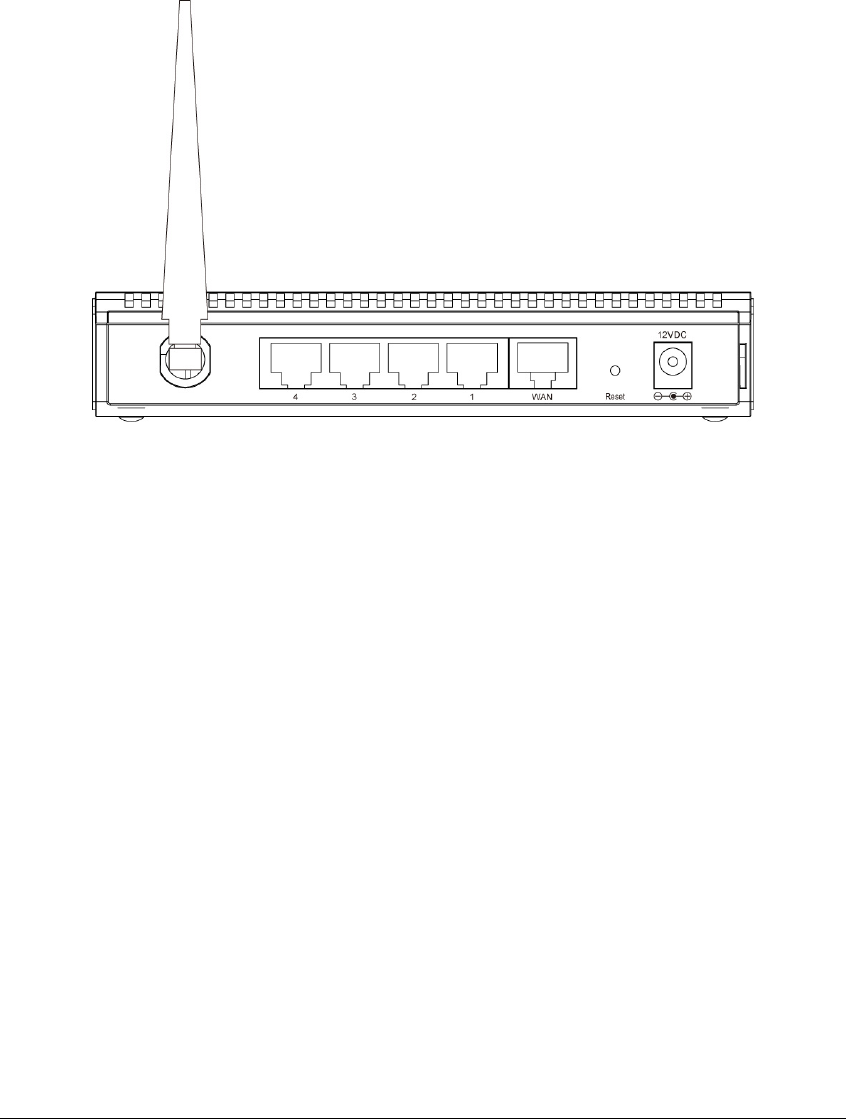
9
Get to know the Broadband Router
Back Panel
The diagram (fig1.0) below shows the broadband router’s back panel. The router’s back panel is
divided into three sections, LAN, WAN and Reset:
Figure 1.0
1) Antenna
There is a 2dBi dipole antenna.
1) Local Area Network (LAN)
The Broadband router’s 4 LAN ports are where you connect your LAN’s PCs, printer servers,
hubs and switches etc.
2) Wide Area Network (WAN)
The WAN port is the segment connected to your xDSL or Cable modem and is linked
to the Internet.
3) Reset
The Reset button allows you to do one of two things.
1) If problems occur with your router, press the router’s reset button with a pencil tip (for
less than 4 seconds) and the router will re-boot itself, keeping your original
configurations.
2) If problems persist or you experience extreme problems or you forgot your password,
press the reset button for longer than 4 seconds and the router will reset itself to the
factory default settings (warning: your original configurations will be replaced with
the factory default settings)

10
Front Panel
On the router’s front panel there are LED lights that inform you of the router’s current status.
Below is an explanation of each LED and its description.
LED Light Status Description
Power ON Router’s power supply is on
WLAN ON Wireless LAN has been activated
OFF Wireless LAN is disabled
Flashing Wireless LAN has Activity (ACT) data being sent
WAN LNK/ACT ON WAN is connected
OFF No WAN connection
Flashing WAN port has Activity (ACT), data being sent
LAN LNK/ACT ON LAN is connected
(Port 1-4) OFF No LAN connection
Flashing LAN port has Activity (ACT), data being sent
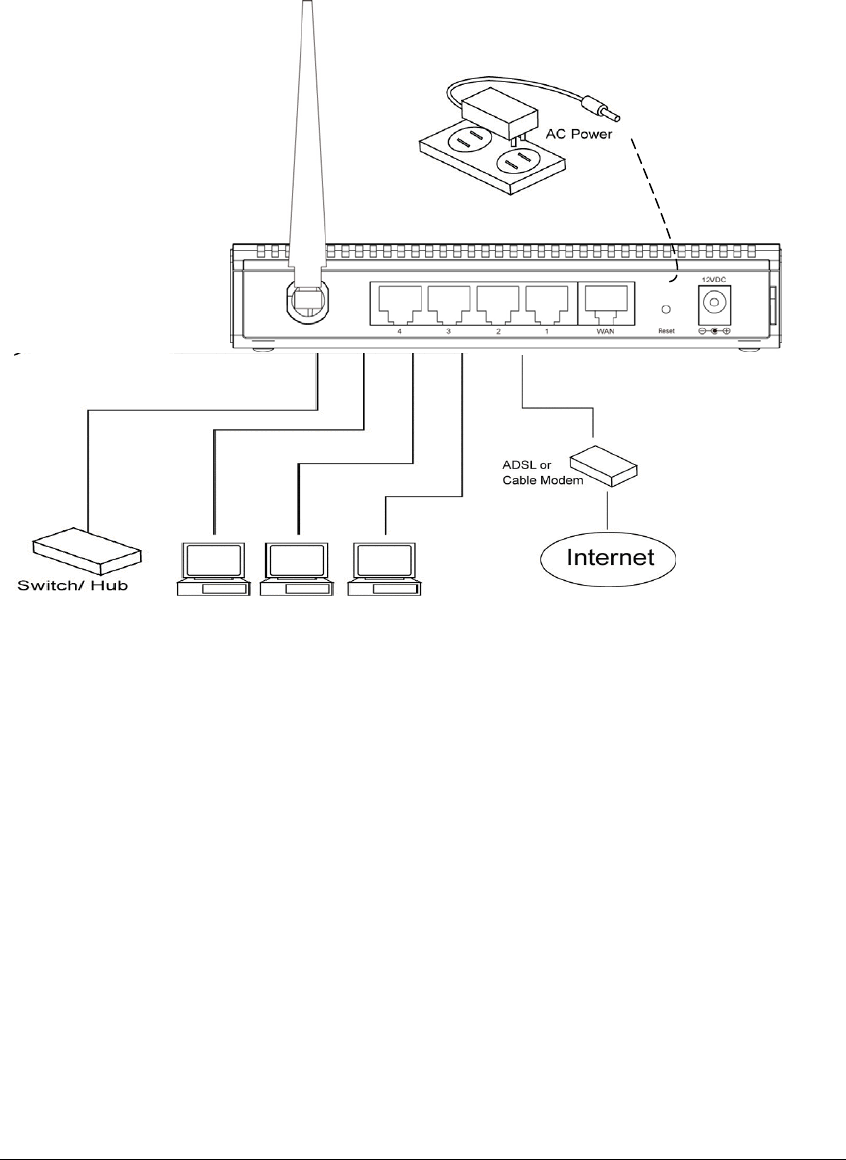
11
Setup Diagram
Figure 1.2 below shows a typical setup for a Local Area Network (LAN).
Figure 1.2
Getting started
This is a step-by-step instruction on how to start using the router and get connected to the
Internet.
1) Setup your network as shown in the setup diagram above (fig 1.2).
2) You then need to set your LAN PC clients so that it can obtain an IP address automatically.
All LAN clients require an IP address. Just like an address, it allows LAN clients to find one
another. (If you have already configured your PC to obtain an IP automatically then proceed
to step 3, page 11)
Configure your PC to obtain an IP address automatically
By default the broadband router’s DHCP is on, this means that you can obtain an IP address
automatically once you’ve configured your PC to obtain an IP address automatically. This
section will show you how to configure your PC’s so that it can obtain an IP address
automatically for either Windows 95/98/Me, 2000 or NT operating systems. For other
operating systems (Macintosh, Sun, etc.), follow the manufacturer’s instructions. The
following is a step-by-step illustration on how to configure your PC to obtain an IP address
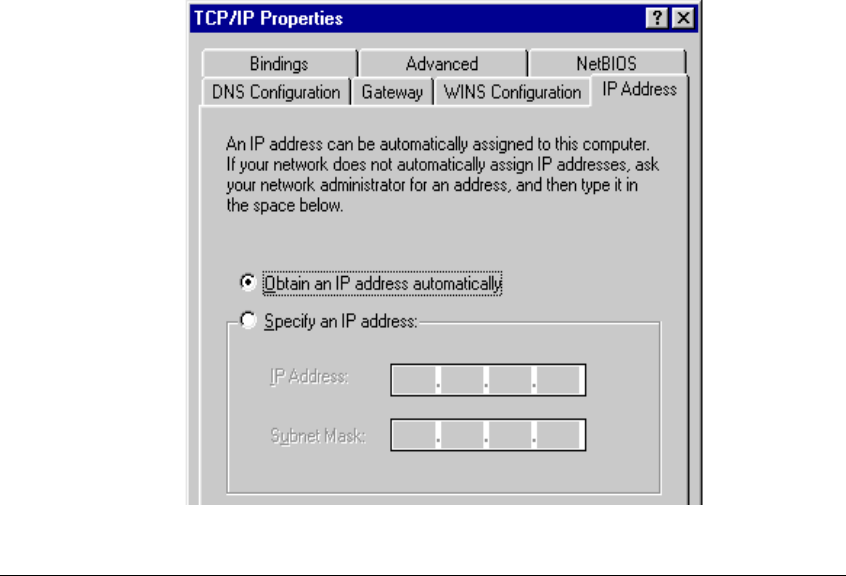
12
automatically for 2a) Windows 95/98/Me, 2b) Windows XP, 2c) Windows 2000, 2d)
Windows NT, and 2e) Windows Vista.
2a) Windows 95/98/Me
1: Click the Start button and select Settings, then click Control Panel. The Control Panel
window will appear.
2: Double-click Network icon. The Network window will appear.
3: Check your list of Network Components. If TCP/IP is not installed, click the Add button to
install it now. If TCP/IP is installed, go to step 6.
4: In the Network Component Type dialog box, select Protocol and click Add button.
5: In the Select Network Protocol dialog box, select Microsoft and TCP/IP and then click the
OK button to start installing the TCP/IP protocol. You may need your Windows CD to
complete the installation.
6: After installing TCP/IP, go back to the Network dialog box. Select TCP/IP from the list of
Network Components and then click the Properties button.
7: Check each of the tabs and verify the following settings:
• Bindings: Check Client for Microsoft Networks and File and printer sharing for
Microsoft Networks.
• Gateway: All fields are blank.
• DNS Configuration: Select Disable DNS.
• WINS Configuration: Select Disable WINS Resolution.
• IP Address: Select Obtain IP address automatically.
8: Reboot the PC. Your PC will now obtain an IP address automatically from your

13
Broadband Router’s DHCP server.
Note: Please make sure that the Broadband router’s DHCP server is the only DHCP server
available on your LAN.
Once you’ve configured your PC to obtain an IP address automatically, please proceed to
Step 3
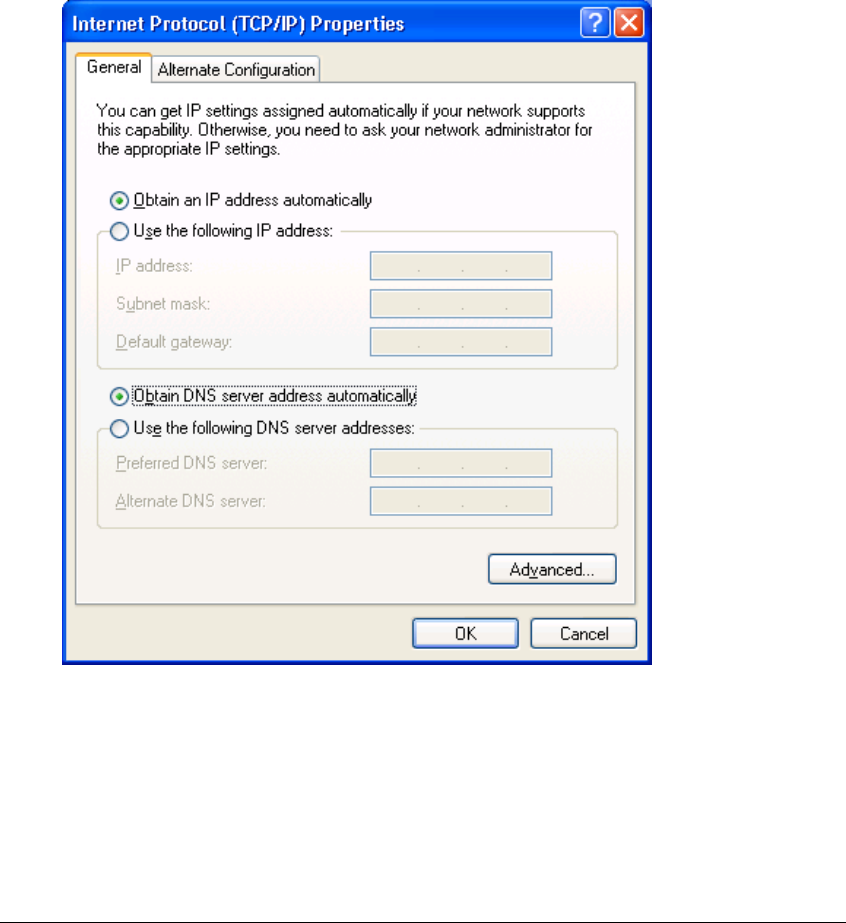
14
2b) Windows XP
1: Click the Start button and select Settings, then click Network Connections. The Network
Connections window will appear.
2: Double-click Local Area Connection icon. The Local Area Connection window will
appear.
3: Check your list of Network Components. You should see Internet Protocol [TCP/IP] on
your list. Select it and click the Properties button.
4: In the Internet Protocol (TCP/IP) Properties window, select Obtain an IP address
automatically and Obtain DNS server address automatically as shown on the following
screen.
5: Click OK to confirm the setting. Your PC will now obtain an IP address automatically
from your Broadband Router’s DHCP server.
Note: Please make sure that the Broadband router’s DHCP server is the only DHCP server
available on your LAN.
Once you’ve configured your PC to obtain an IP address automatically, please proceed to
Step 3.
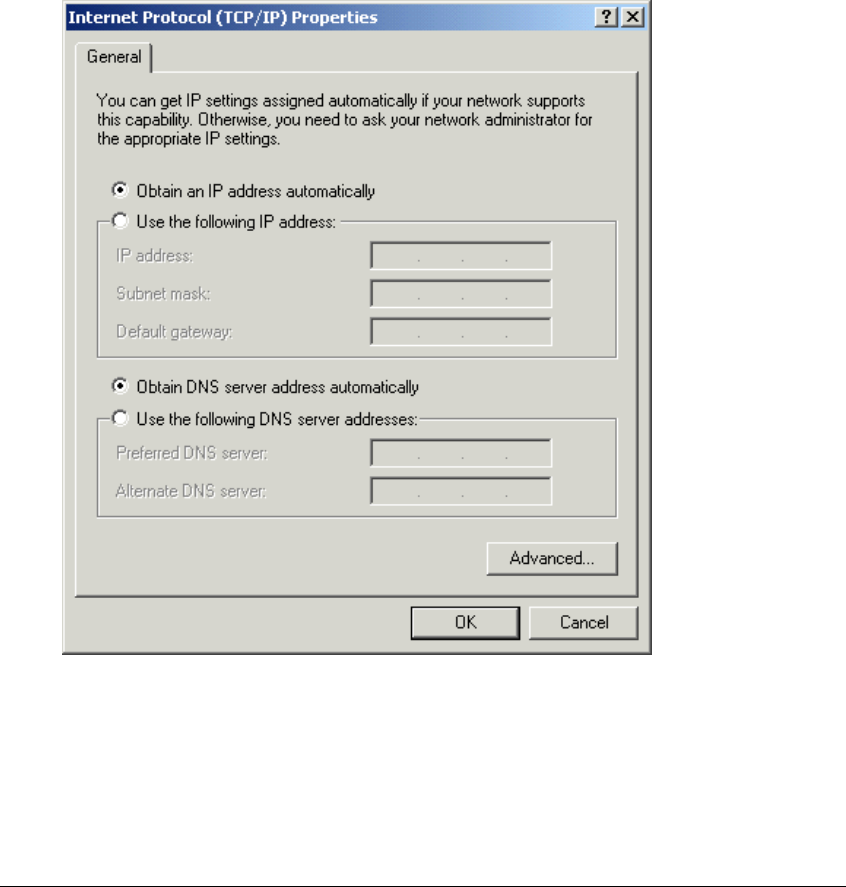
15
2c) Windows 2000
1: Click the Start button and select Settings, then click Control Panel. The Control Panel
window will appear.
2: Double-click Network and Dial-up Connections icon. In the Network and Dial-up
Connection window, double-click Local Area Connection icon. The Local Area
Connection window will appear.
3: In the Local Area Connection window, click the Properties button.
4: Check your list of Network Components. You should see Internet Protocol [TCP/IP] on
your list. Select it and click the Properties button.
5: In the Internet Protocol (TCP/IP) Properties window, select Obtain an IP address
automatically and Obtain DNS server address automatically as shown on the following
screen.
6: Click OK to confirm the setting. Your PC will now obtain an IP address automatically
from your Broadband Router’s DHCP server.
Note: Please make sure that the Broadband router’s DHCP server is the only DHCP server
available on your LAN.
Once you’ve configured your PC to obtain an IP address automatically, please proceed to
Step 3.
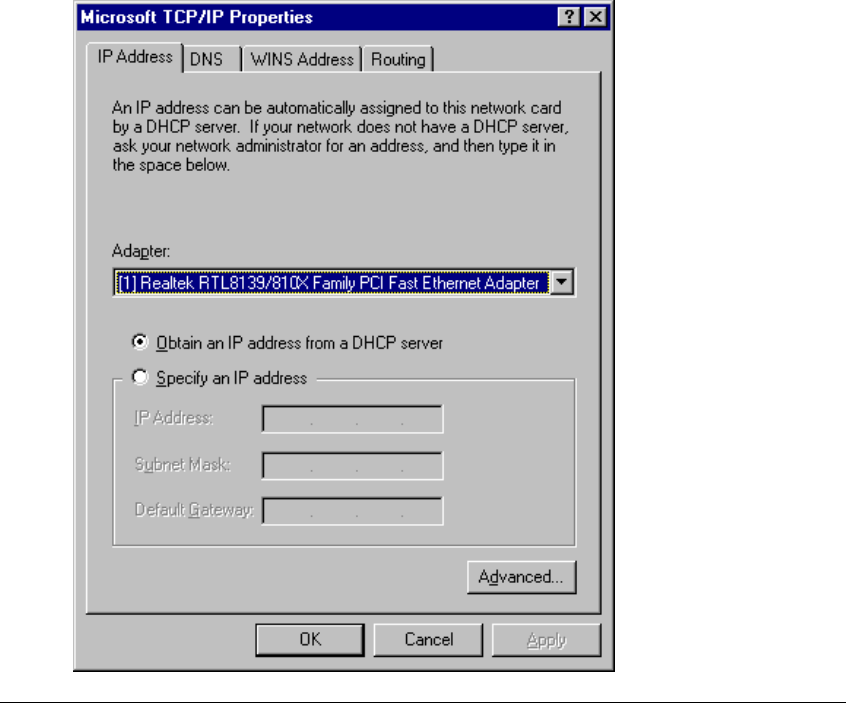
16
2d) Windows NT
1: Click the Start button and select Settings, then click Control Panel. The Control Panel
window will appear.
2: Double-click Network icon. The Network window will appear. Select the Protocol tab from
the Network window.
3: Check if the TCP/IP Protocol is on your list of Network Protocols. If TCP/IP is not
installed, click the Add button to install it now. If TCP/IP is installed, go to step 5.
4: In the Select Network Protocol window, select the TCP/IP Protocol and click the Ok
button to start installing the TCP/IP protocol. You may need your Windows CD to
complete the installation.
5: After you install TCP/IP, go back to the Network window. Select TCP/IP from the list of
Network Protocols and then click the Properties button.
6: Check each of the tabs and verify the following settings:
• IP Address: Select Obtain an IP address from a DHCP server.
• DNS: Let all fields are blank.
• WINS: Let all fields are blank.
• Routing: Let all fields are blank.

17
7: Click OK to confirm the setting. Your PC will now obtain an IP address automatically
from your Broadband Router’s DHCP server.
Note: Please make sure that the Broadband router’s DHCP server is the only DHCP server
available on your LAN.
Once you’ve configured your PC to obtain an IP address automatically, please proceed to
Step 3.
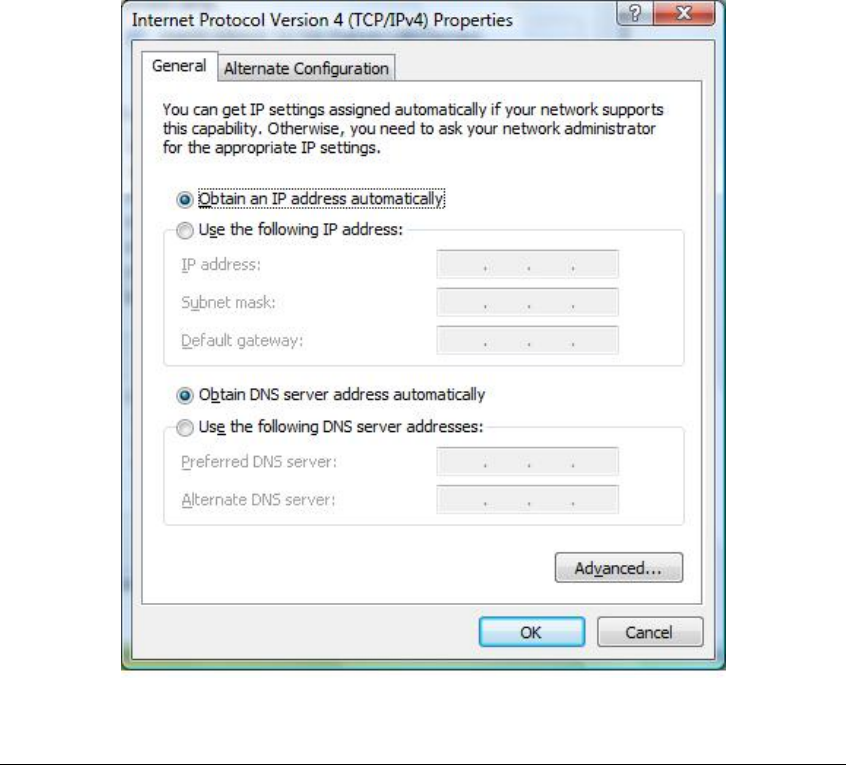
18
2e) Windows Vista
1. Click the Start button and select Settings and then select Control Panel. Double
click Network and Sharing Center, the Network and Sharing Center window will
appear.
2. Click Manage network connections and right click on the Local Area Connection
icon and select Properties. The Local Area Connection window will appear.
3. Check your list of Network Components. You should see Internet Protocol Version 4
(TCP/IPv4) on your list. Select it and click the Properties button.
4. In the Internet Protocol Version 4 (TCP/IPv4) Properties window, select Obtain an
IP address automatically and Obtain DNS server address automatically as shown on
the following screen.

19
5. Click OK to confirm the setting. Your PC will now obtain an IP address
automatically from your router’s DHCP server.
Note: Please make sure that the Broadband router’s DHCP server is the only DHCP server
available on your LAN.
Once you’ve configured your PC to obtain an IP address automatically, please proceed to
Step 3.
3) Once you have configured your PCs to obtain an IP address automatically, the router’s
DHCP server will automatically give your LAN clients an IP address. By default the
Broadband Router’s DHCP server is enabled so that you can obtain an IP address
automatically. To see if you have obtained an IP address, see Appendix A.
Note: Please make sure that the Broadband router’s DHCP server is the only DHCP server
available on your LAN. If there is another DHCP on your network, then you’ll need to switch
one of the DHCP servers off. (To disable the Broadband router’s DHCP server see chapter 3
LAN Port)
4) Once your PC has obtained an IP address from your router, enter the default IP address
192.168.2.1 (broadband router’s IP address) into your PC’s web browser and press <enter>
5) The login screen below will appear. Enter the “User Name” and “Password” and then click
<OK> to login.
Note: By default the user name is “admin” and the password is “1234”. For security
reasons it is recommended that you change the password as soon as possible (in
General setup/system/password, see chapter 3)
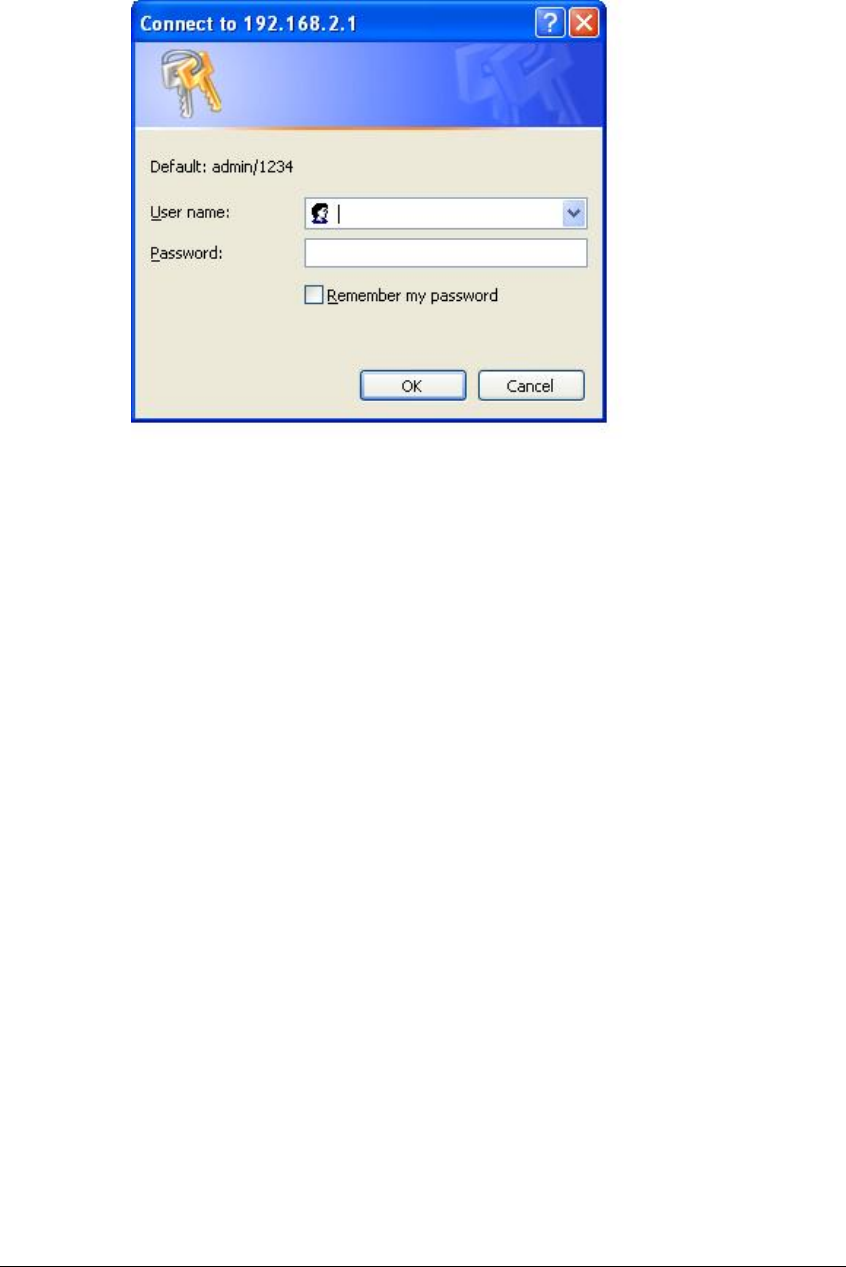
20
6) The HOME page screen below will appear. The Home Page is divided into four sections,
Quick Setup Wizard, General Setup, Status Information and Tools.
Quick Setup Wizard (Chapter 2)
If you only want to start using the broadband router as an Internet Access device then you
ONLY need to configure the screens in the Quick Setup Wizard section.
General Setup (Chapter 3)
If you want to use more advanced features that the broadband router has to offer, then you’ll
need to configure the Quick Setup Wizard and the General Setup section. Alternatively, you
can just configure the General Setup section, since the General Setup/WAN and the Quick
Setup Wizard contain the same configurations.
Status Information (Chapter 4)
The Status Information section is for you to monitor the router’s current status information
only.
Tools (Chapter 5)
If you want to Reset the router (because of problems) or save your configurations or upgrade
the firmware then the Tools section is the place to do this.
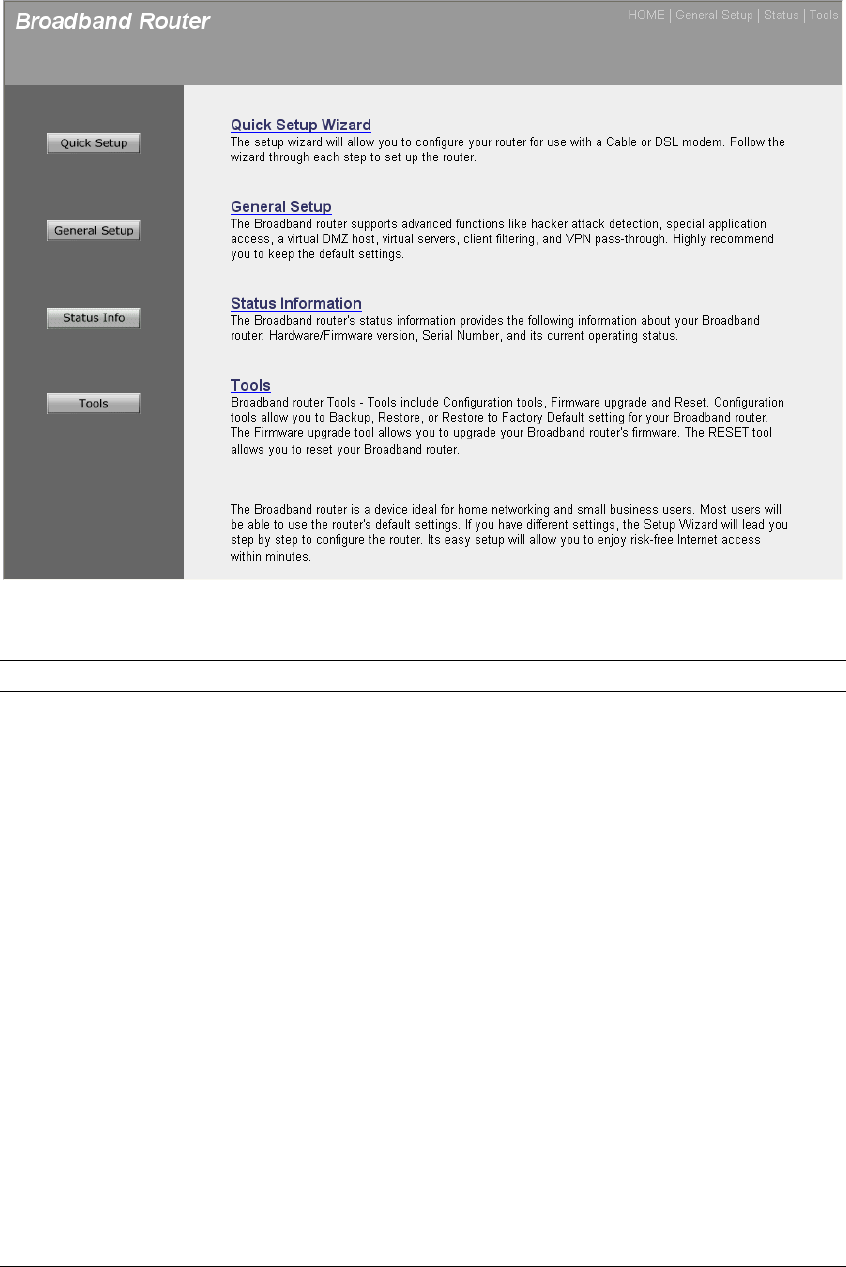
21
Menu Description
Quick Setup Wizard (Chapter 2) Select your Internet connection type and then
input the configurations needed to connect to
your Internet Service Provider (ISP).
General Setup (Chapter 3) This section contains configurations for the
Broadband router’s advance functions such as:
Address Mapping, Access Control, Hacker
Attack Prevention, DMZ, Special applications
and other functions to meet your LAN
requirements.
Status Information (Chapter 4) In this section you can see the Broadband
router's system information, Internet Connection,
Device Status, System Log, Security Log and
DHCP client information.
Tools (Chapter 5) This section contains the broadband router’s
Tools - Tools include Configuration tools,
Firmware upgrade and Reset. Configuration
tools allow you to Backup (save), Restore, or
Restore to Factory Default configuration for your
Broadband router. The Firmware upgrade tool
allows you to upgrade your Broadband router's

22
firmware. The RESET tool allows you to reset
your Broadband router.
7) Click on Quick Setup Wizard (see chapter 2) to start configuring settings required by your
ISP so that you can start accessing the Internet. The other sections (General Setup, Status
Information and Tools) do not need to be configured unless you wish to implement/monitor
more advance features/information.
Select the section (Quick Setup Wizard, General Setup, Status Information and Tools) you wish
to configure and proceed to the corresponding chapter. Use the selections on the web
management’s top right hand page (see below) to navigate around the web-based management
User Interface.
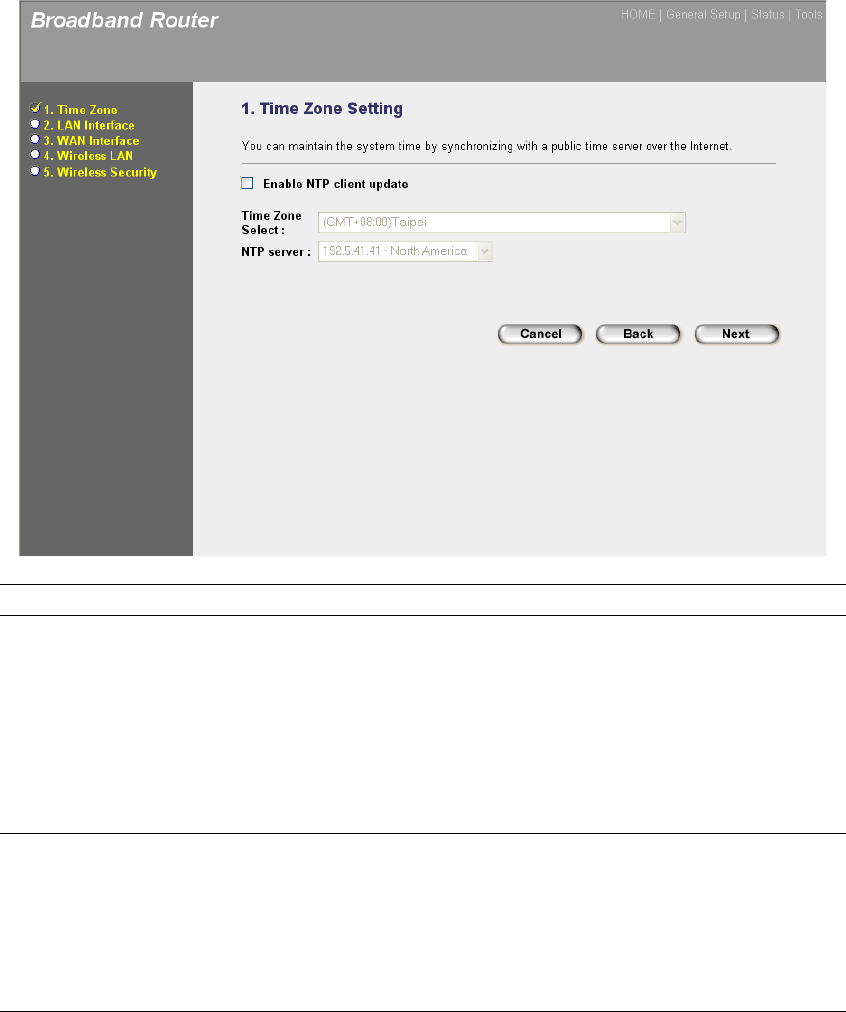
23
Chapter 2
Quick Setup
The Quick Setup section is designed to get you using the broadband router as quick as possible.
In the Quick Setup you are required to fill in only the information necessary to access the Internet.
Once you click on the Quick Setup Wizard in the HOME page, you should see the screen below.
Step 1) Time Zone
The Time Zone allows your router to base its time on the settings configured here, this will affect
functions such as Log entries and Firewall settings.
Parameter Description
Enable NTP client update Check this box to enable the auto time synchronization
function. The router will set its time based on your
selection.
Time Zone Select You can select your local time zone here. The router
will sync time according to your time zone selection.
NTP server Select the time server to synchronize with.
Click on NEXT to proceed to the next page (step 2) LAN Interface.
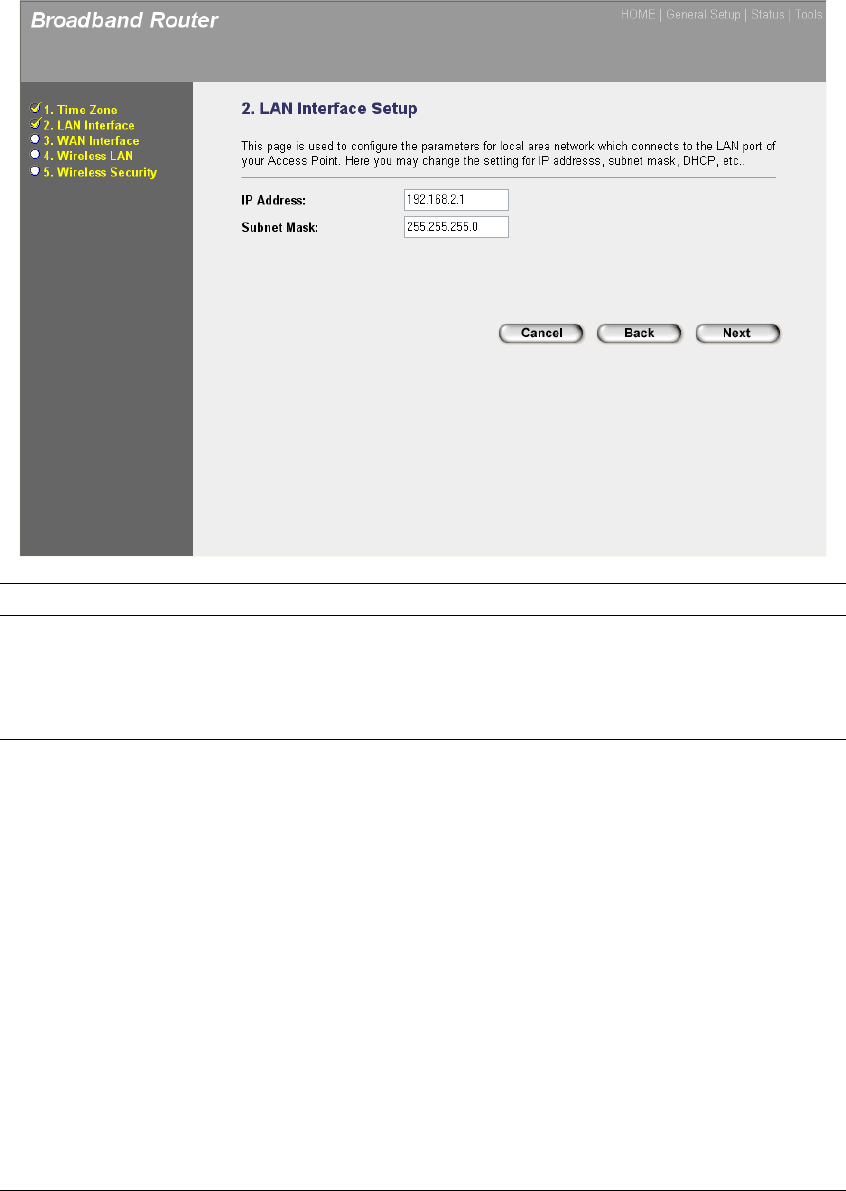
24
Step 2) LAN Interface
The LAN Interface settings allow you to configure the parameters for local area network.
Parameter Description
IP Address This is the router’s LAN port IP address (Your LAN
clients default gateway IP address)
Subnet Mask Specify a Subnet Mask for your LAN segment.
Click on NEXT to proceed to the next page (step 3) WAN Interface.
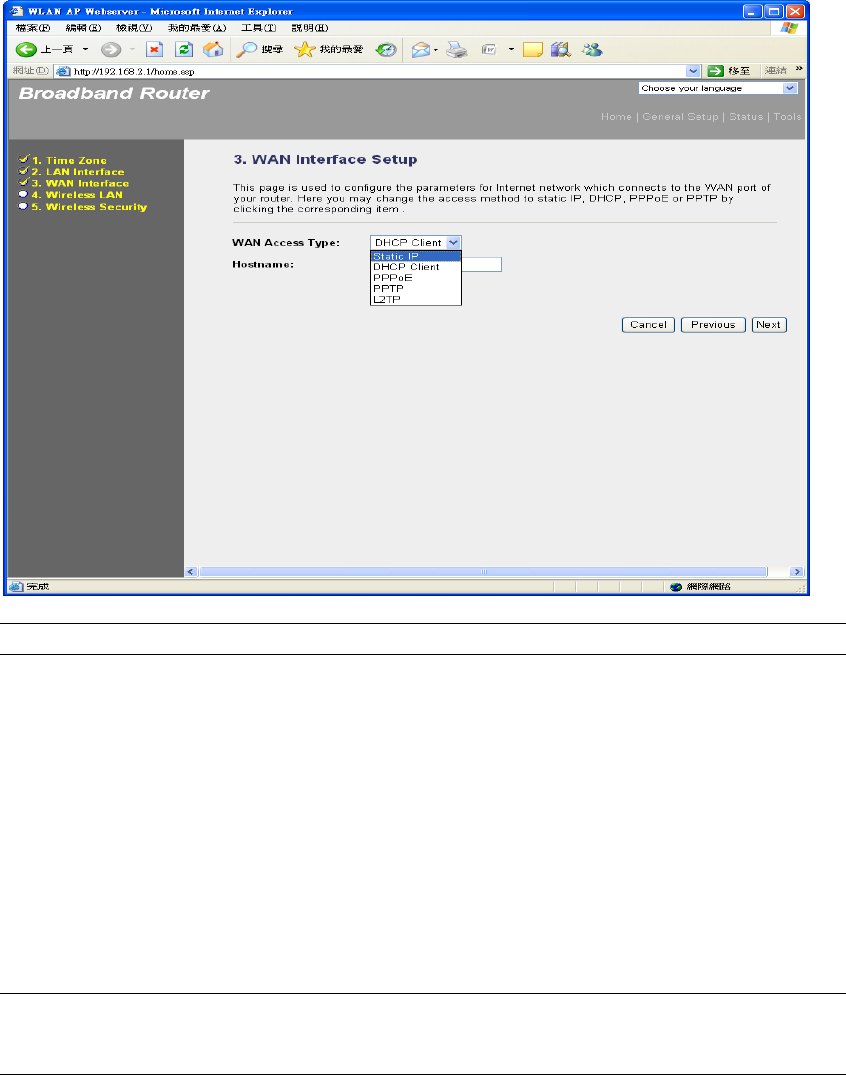
25
Step 3) WAN Interface
In this section you have to select one of four types of connections that you will be using to
connect your broadband router’s WAN port to your ISP (see screen below).
Note: Different ISP’s require different methods of connecting to the Internet, please check with
your ISP as to the type of connection it requires.
Menu Description
2.31 Static IP Your ISP has given you an IP address already
2.32 DHCP Client Your ISP will automatically give you an IP address
2.33 PPPoE Your ISP requires you to use a Point-to-Point Protocol over
Ethernet (PPPoE) connection.
2.34 PPTP Your ISP requires you to use a Point-to-Point Tunneling Protocol
(PPTP) connection.
2.35 L2TP Your ISP requires you to use a Point-to-Point Tunneling Protocol
(L2TP) connection.
Select one of the WAN types and set the manual’s relevant sub-section (2.31, 2.32, 2.33, or 2.34).
Click on Back to return to the previous screen.
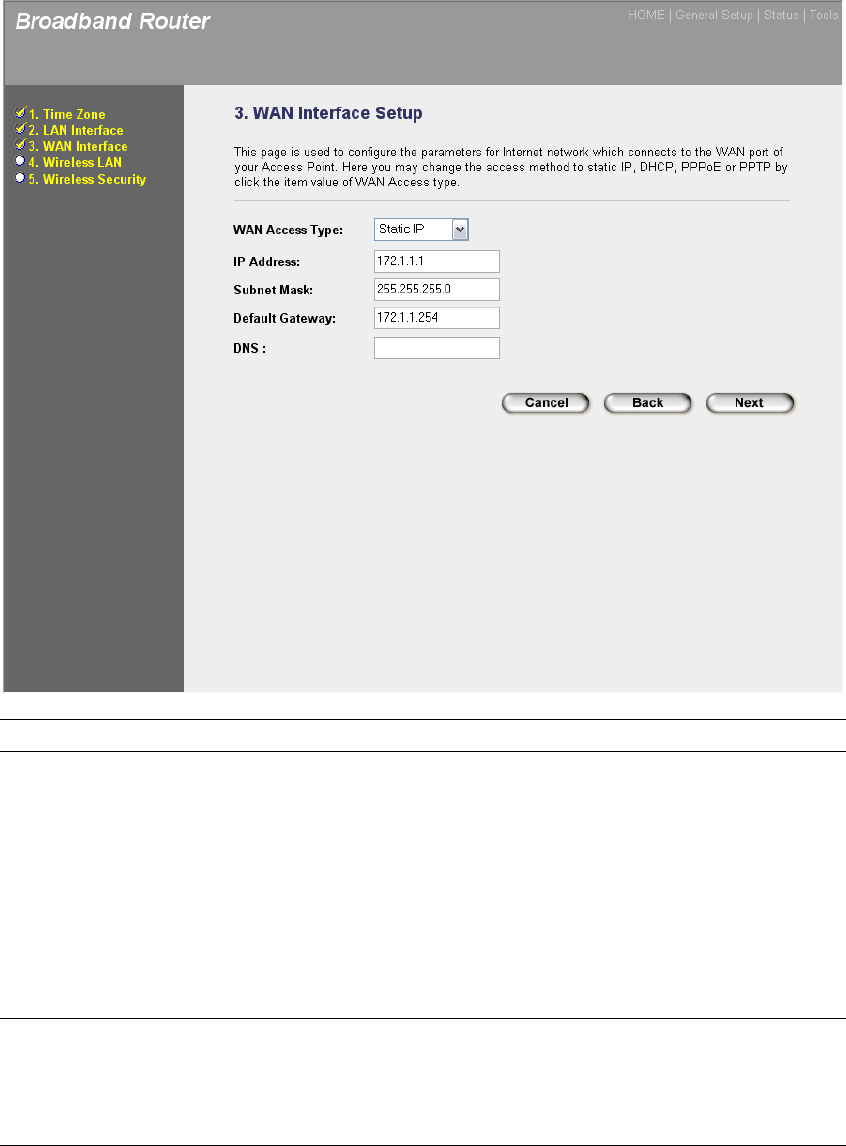
26
2.31 Static IP
Select Static IP if your ISP has given you a specific IP address for you to use. Your ISP should
provide all the information required in this section.
Parameters Description
IP Address This is the IP address that your ISP has given you.
Subnet Mask Enter the Subnet Mask provided by your ISP
(e.g. 255.255.255.0)
Default Gateway IP This is the ISP’s IP address gateway
DNS This is the ISP’s DNS server IP address
Click on NEXT to proceed to the next page (step 4) Wireless Basic Settings.
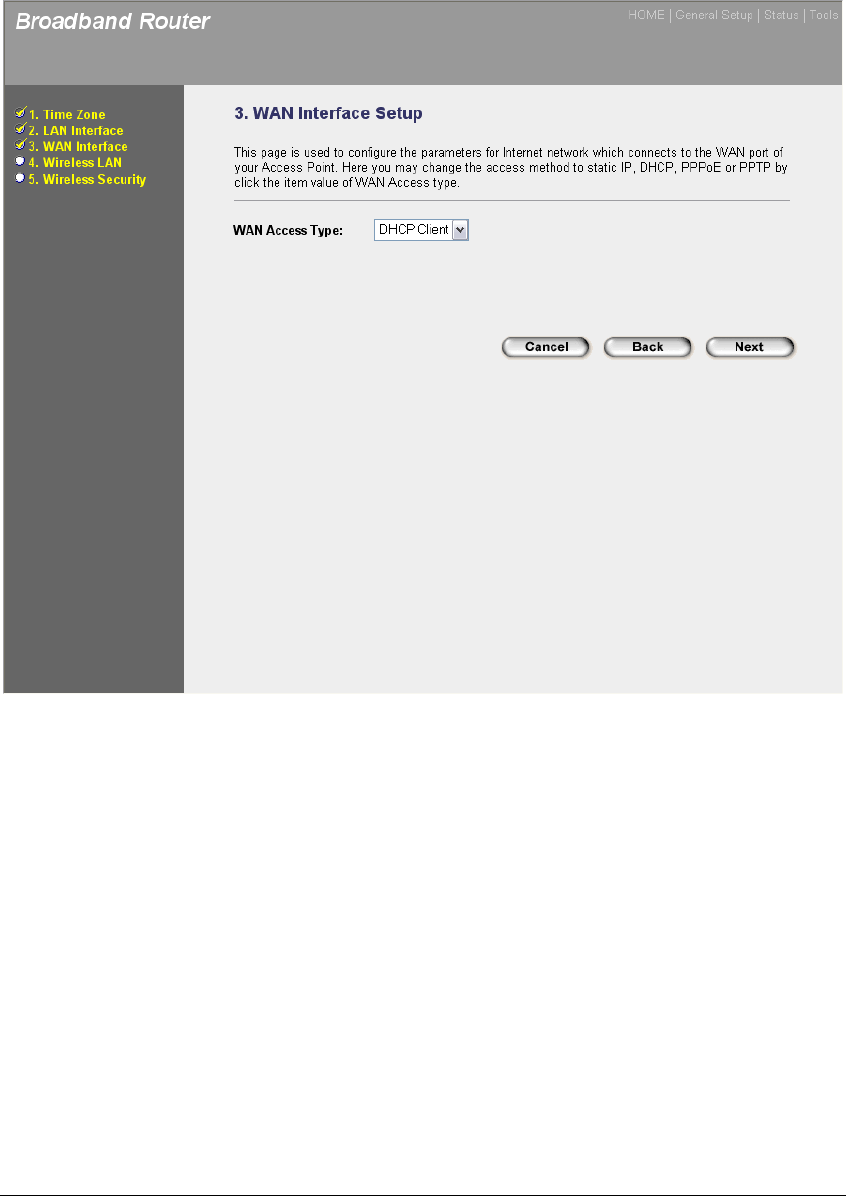
27
2.32 DHCP Client
Choose DHCP Client if your ISP will automatically give you an IP address.
Click on NEXT to proceed to the next page (step 4) Wireless Basic Settings.
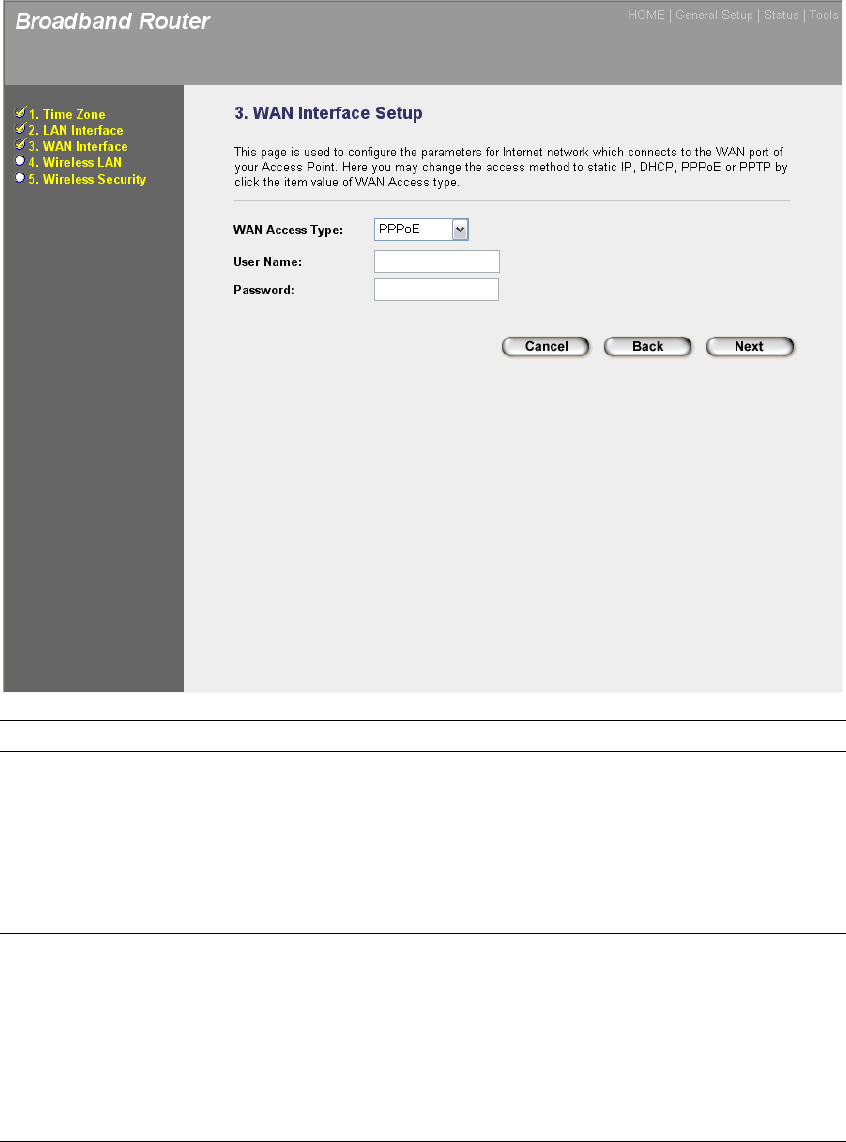
28
2.33 PPPoE
Select PPPoE if your ISP requires the PPPoE protocol to connect you to the Internet. Your ISP
should provide all the information required in this section.
Parameter Description
User Name Enter the User Name provided by your ISP for the PPPoE
connection
Password Enter the Password provided by your ISP for the PPPoE
connection
Click on NEXT to proceed to the next page (step 4) Wireless Basic Settings.
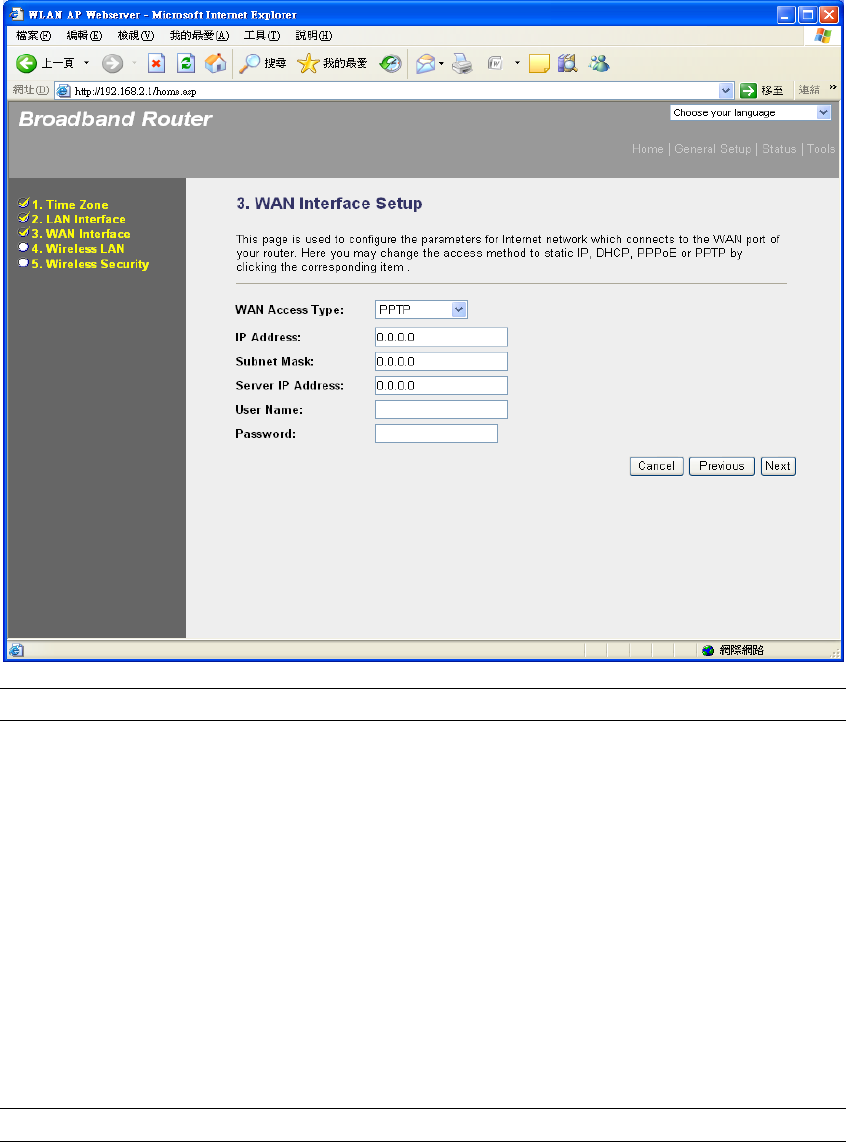
29
2.34 PPTP
Select PPTP if your ISP requires the PPTP protocol to connect you to the Internet. Your ISP
should provide all the information required in this section.
Parameter Description
IP Address This is the IP address that your ISP has given you to
establish a PPTP connection.
Subnet Mask Enter the Subnet Mask provided by your ISP
(e.g. 255.255.255.0)
Server IP Address Enter the IP address of the ISP Gateway
User Name Enter the User Name provided by your ISP for the PPTP
connection. Sometimes called a Connection ID
Password Enter the Password provided by your ISP for the PPTP
connection
Click on NEXT to proceed to the next page (step 4) Wireless Basic Settings.
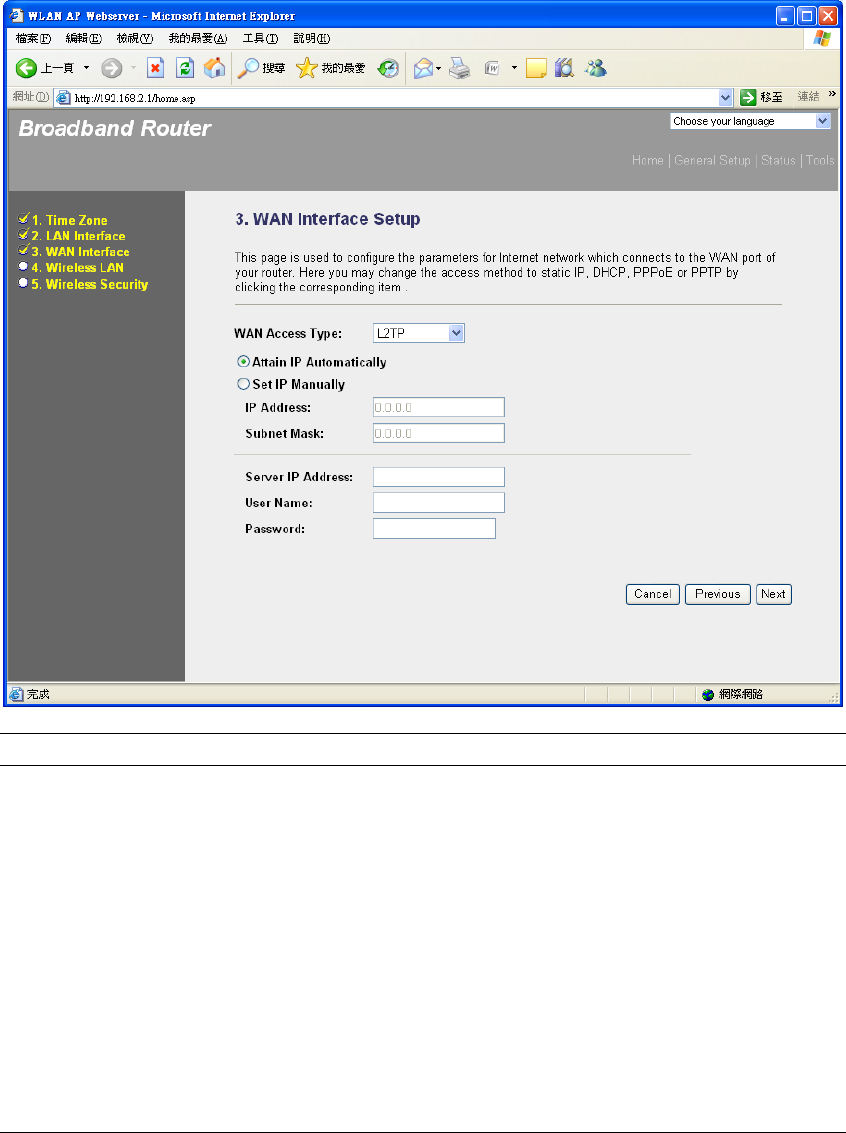
30
2.35 L2TP
Select L2TP if your ISP requires the L2TP protocol to connect you to the Internet. Your
ISP should provide all the information required in this section.
Parameter Description
Attain IP Automatically The ISP requires you to obtain an IP address by DHCP
before connecting to the L2TP server.
Set IP Manually The ISP gives you a static IP to be used to connect to the
L2TP server.
IP Address This is the IP address that your ISP has given you to
establish a L2TP connection.
Subnet Mask Enter the Subnet Mask provided by your ISP
Server IP Address Enter the IP address of the ISP Gateway
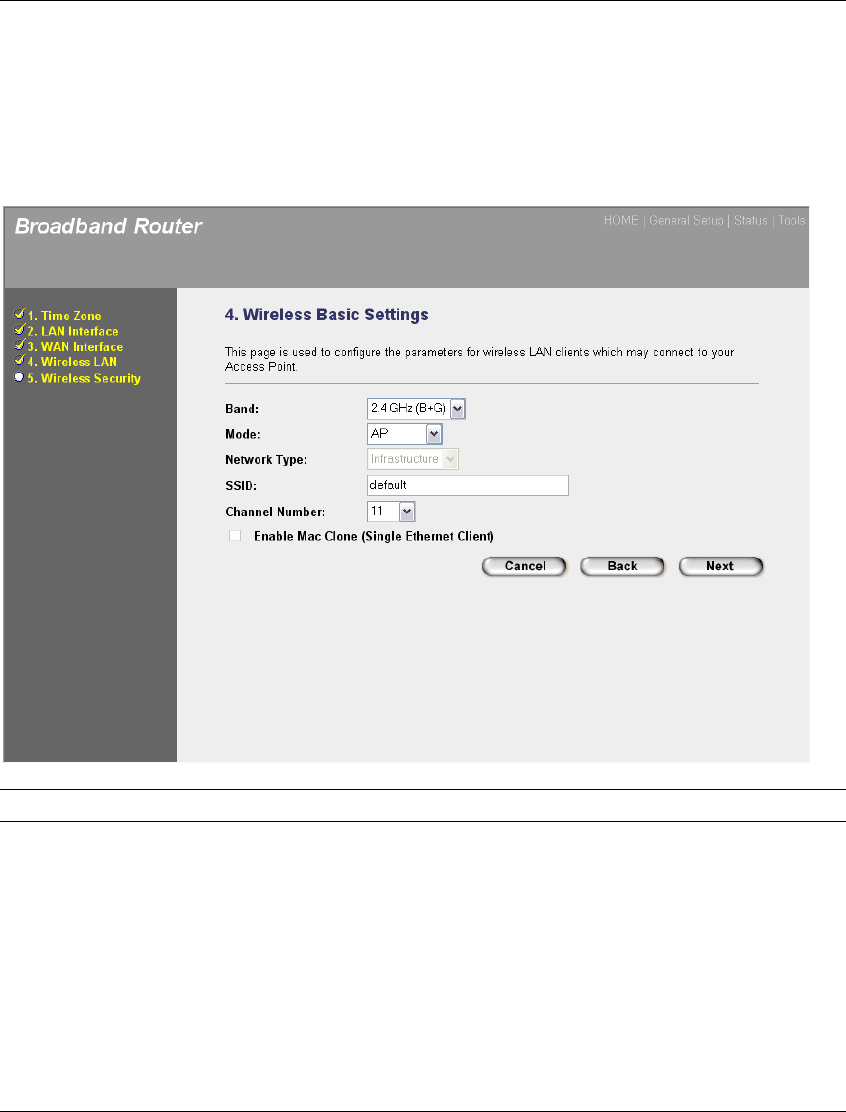
31
User Name Enter the User Name provided by your ISP for the L2TP
connection. Sometimes called a Connection ID
Password Enter the Password provided by your ISP for the L2TP
connection
Click on NEXT to proceed to the next page (step 4) Wireless Basic Settings.
Step 4) Wireless Basic Settings
Wireless Access Point builds a wireless LAN and can let all PCs equipped with IEEE
802.11b or 801.11g wireless network adaptor connect to your Intranet. It supports WEP
and WPA2 encryption to enhance the security of your wireless network.
Menu Description
Band It allows you to set the AP fix at 802.11b or 802.11g mode.
You also can select B+G mode to allow the AP select
802.11b and 802.11g connection automatically.
Mode It allows you to set the AP to AP, Client, WDS or AP +
WDS mode.
Network Type In client mode, you can specify your client to connect as an
infrastructure client or an ad hoc client.
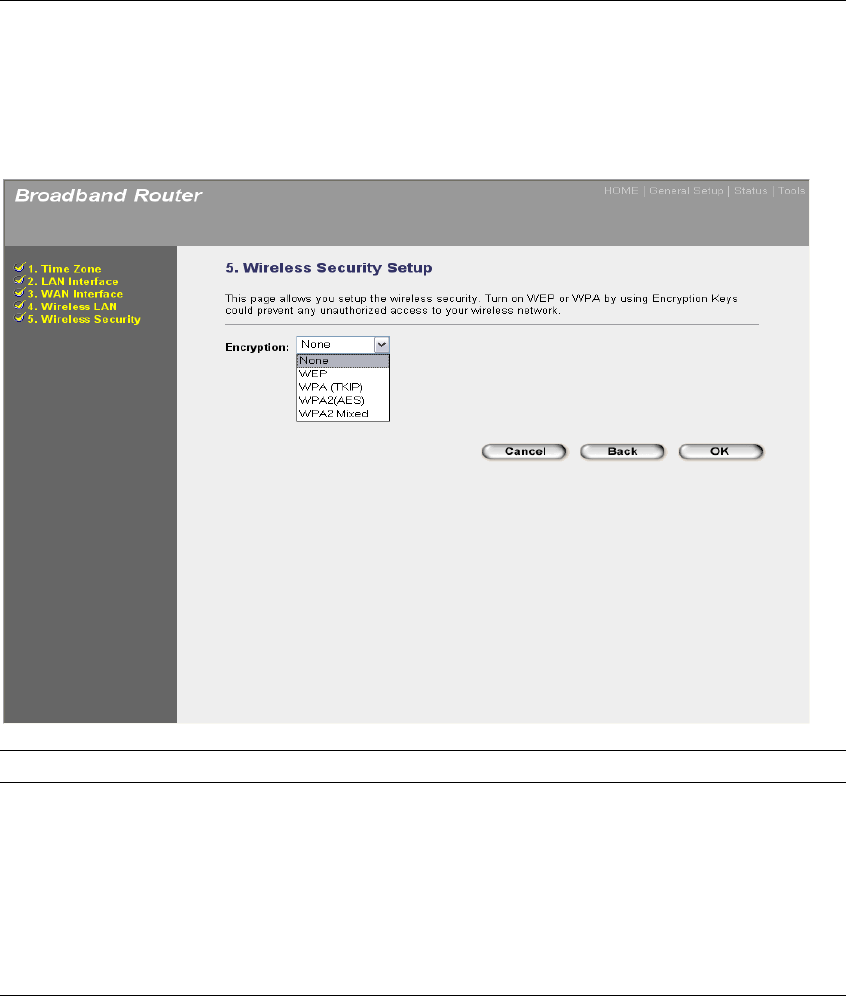
32
SSID This is the name of the wireless LAN. All the devices in the
same wireless LAN should have the same ESSID.
Channel Number The channel used by the wireless LAN. All devices in the
same wireless LAN should use the same channel.
Enable MAC Clone Check the check box will let router copy the first seen
MAC address to the WLAN MAC.
Click on NEXT to proceed to the next page (step 5) Wireless Security.
Step 5) Wireless Security Settings
This page allows you setup the wireless security. Turn on WEP or WPA by using
Encryption Keys could prevent any unauthorized access to your wireless network.
Menu Description
None Do not apply any encryption to wireless usage. Everyone can
access the wireless without permission.
2.51 WEP You can select the WEP key length for encryption, 64-bit or 128-bit. Larger WEP
key length will provide higher level of security, but the throughput will be lower.
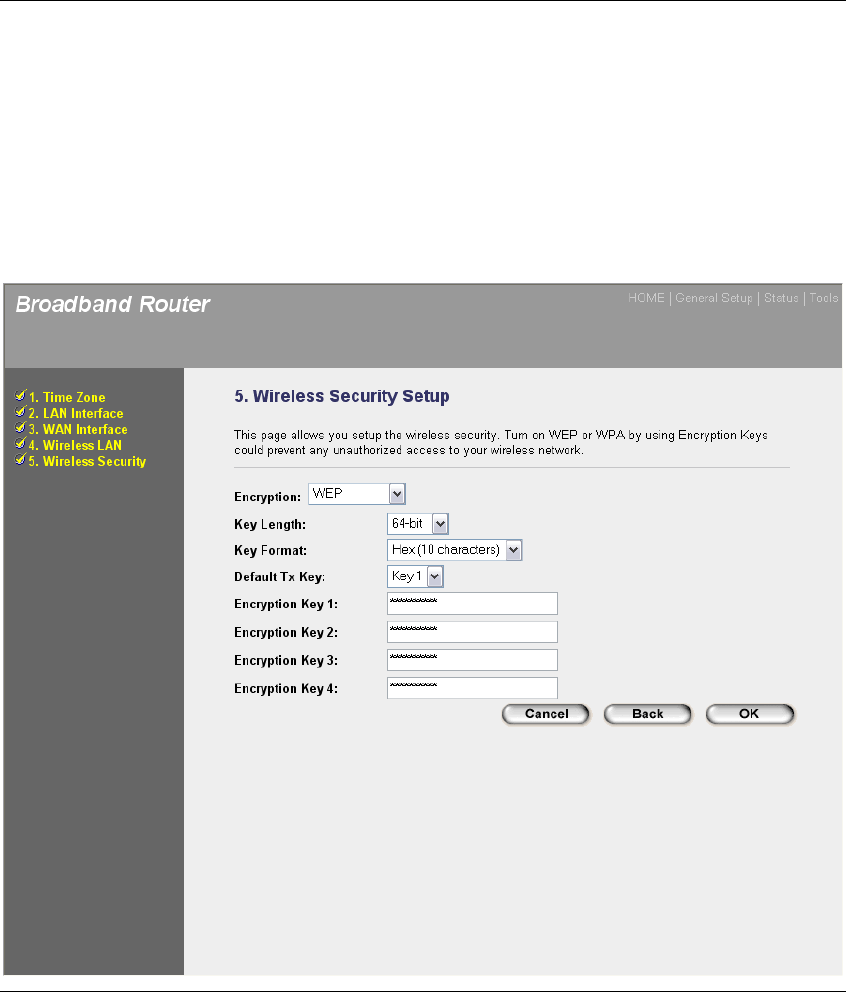
33
2.52 WPA(TKIP) You can use a pre-shared key to authenticate wireless stations
and encrypt data during communication. And use TKIP to
change the encryption key frequently.
2.53 WPA2(AES) You can use a pre-shared key to authenticate wireless stations
and encrypt data during communication. And use CCMP(AES) to
change the encryption key frequently.
2.54 WPA2 Mixed This will use TKIP or AES based on the other communication
peer automatically.
Select one of the Security types and set the manual’s relevant sub-section (2.51, 2.52, 2.53, or
2.54). Click on Back to return to the previous screen.
2.51 WEP
When you select 64-bit or128-bit WEP key, you have to enter WEP keys to encrypt data.
You can generate the key by yourself and enter it. You can enter four WEP keys and
select one of them as default key. Then the router can receive any packets encrypted by
one of the four keys.

34
Parameters Description
Key Length You can select the WEP key length for encryption,
64-bit or 128-bit. Larger WEP key length will
provide higher level of security, but the throughput
will be lower.
Key Format You may select to select ASCII Characters
(alphanumeric format) or Hexadecimal Digits (in
the "A-F", "a-f" and "0-9" range) to be the WEP
Key.
For example:
ASCII Characters: guest
Hexadecimal Digits: 12345abcde
Default Tx Key Select one of the four keys to encrypt your data.
Only the key you select it in the "Default key" will
take effect.
Encryption Key 1~4 The WEP keys are used to encrypt data transmitted
in the wireless network. Fill the text box by
following the rules below.
64-bit WEP: input 10-digit Hex values (in the "A-F",
"a-f" and "0-9" range) or 5-digit ASCII character as
the encryption keys.
128-bit WEP: input 26-digit Hex values (in the "A-
F", "a-f" and "0-9" range) or 13-digit ASCII
characters as the encryption keys.
Clicking on OK to save and active all the settings. Now, you can start to use the router as your
internet gateway.
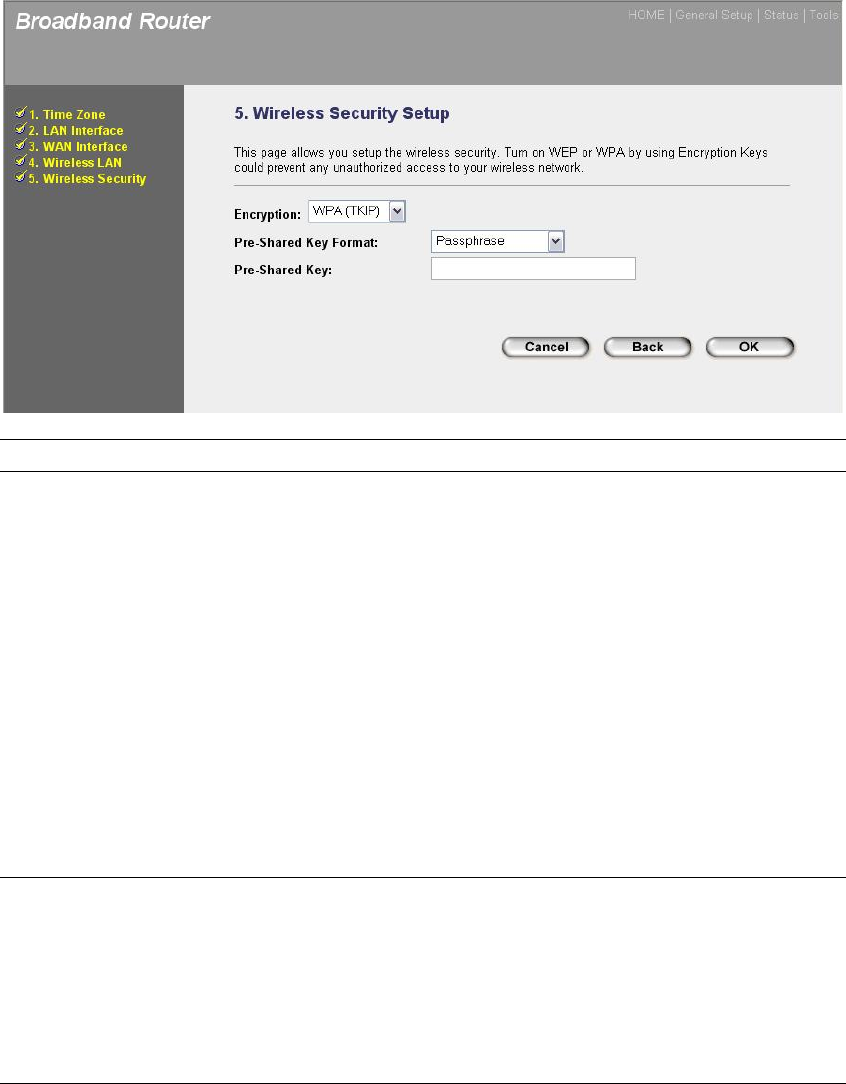
35
2.52 WPA(TKIP)
Wi-Fi Protected Access (WPA) is an advanced security standard. You can use a pre-
shared key to authenticate wireless stations and encrypt data during communication. It
uses TKIP to change the encryption key frequently. So the encryption key is not easy to
be broken by hackers. This can improve security very much.
Parameters Description
Pre-shared Key Format You may select to select Passphrase (alphanumeric
format) or Hexadecimal Digits (in the “A-F”, “a-f”
and “0-9” range) to be the Pre-shared Key. For
example:
Passphrase: iamguest
Hexadecimal Digits: 12345abcde
Pre-shared Key The Pre-shared key is used to authenticate and
encrypt data transmitted in the wireless network.
Fill the text box by following the rules below.
Hex: input 64-digit Hex values (in the “A-F”, “a-f”
and “0-9” range) or at least 8 character pass phrase
as the pre-shared keys.
Clicking on OK to save and active all the settings. Now, you can start to use the router as your
internet gateway.
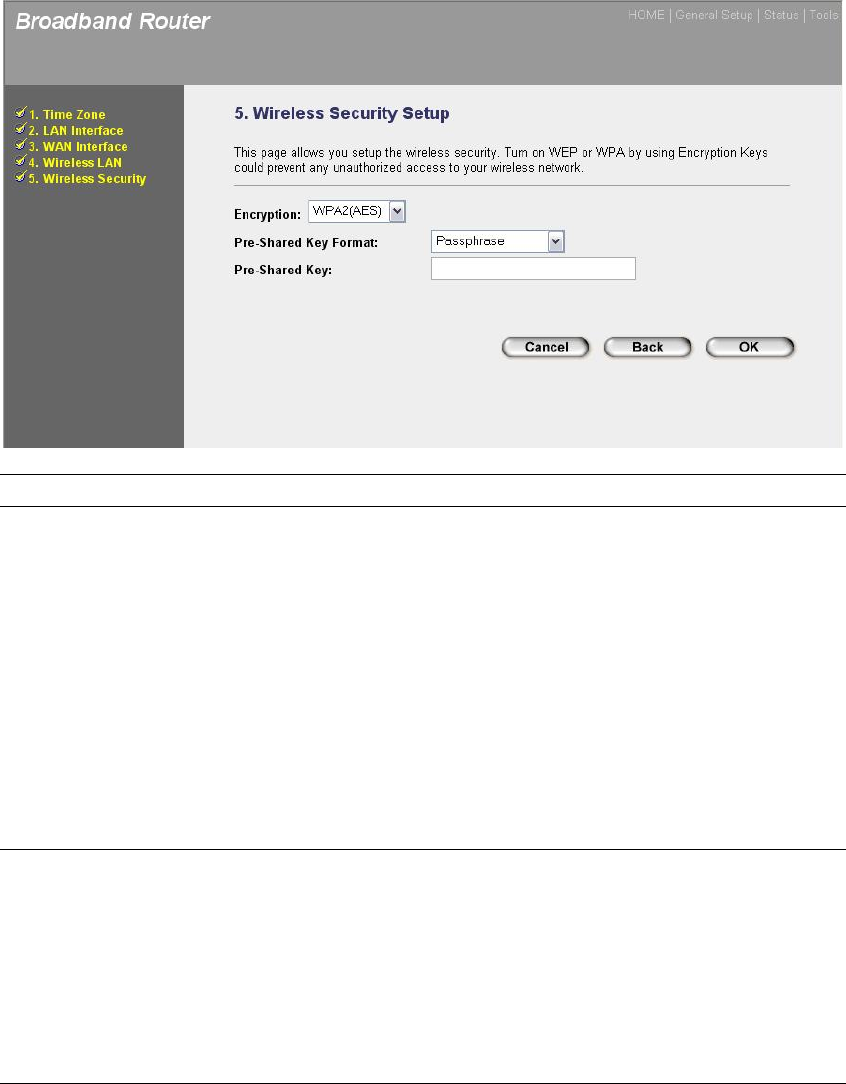
36
2.53 WPA2(AES)
Wi-Fi Protected Access 2(WPA2) is an advanced security standard. You can use a pre-
shared key to authenticate wireless stations and encrypt data during communication. It
uses CCMP(AES) to change the encryption key frequently. So the encryption key is not
easy to be broken by hackers. This can improve security very much.
Parameters Description
Pre-shared Key Format You may select to select Passphrase (alphanumeric format) or
Hexadecimal Digits (in the “A-F”, “a-f” and “0-9” range) to
be the Pre-shared Key. For example:
Passphrase: iamguest
Hexadecimal Digits: 12345abcde
Pre-shared Key The Pre-shared key is used to authenticate and encrypt data
transmitted in the wireless network. Fill the text box by
following the rules below.
Hex: input 64-digit Hex values (in the “A-F”, “a-f”
and “0-9” range) or at least 8 character pass phrase
as the pre-shared keys.
Clicking on OK to save and active all the settings. Now, you can start to use the router as your
internet gateway.
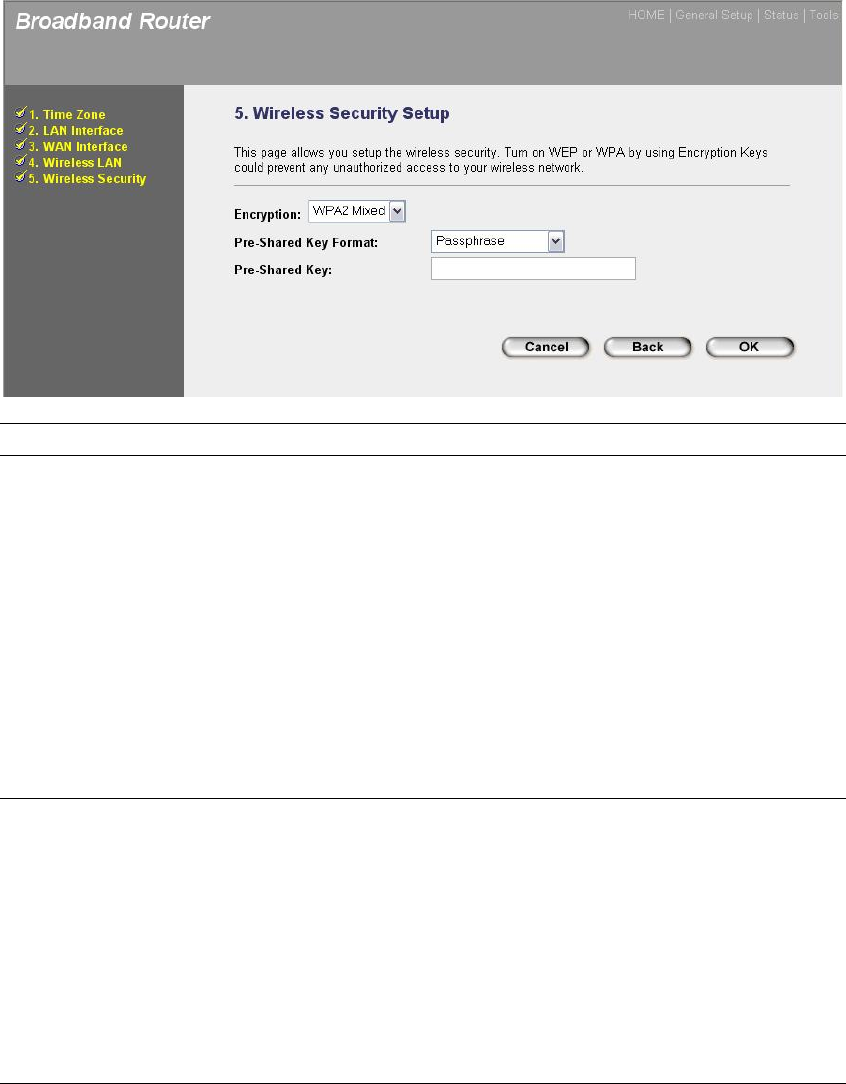
37
2.54 WPA2 Mixed
Wi-Fi Protected Access 2(WPA2) is an advanced security standard. You can use a pre-
shared key to authenticate wireless stations and encrypt data during communication. It
uses TKIP or CCMP(AES) to change the encryption key frequently. So the encryption
key is not easy to be broken by hackers. This can improve security very much.
Parameters Description
Pre-shared Key Format You may select to select Passphrase (alphanumeric format) or
Hexadecimal Digits (in the “A-F”, “a-f” and “0-9” range) to
be the Pre-shared Key. For example:
Passphrase: iamguest
Hexadecimal Digits: 12345abcde
Pre-shared Key The Pre-shared key is used to authenticate and encrypt data
transmitted in the wireless network. Fill the text box by
following the rules below.
Hex: input 64-digit Hex values (in the “A-F”, “a-f”
and “0-9” range) or at least 8 character pass phrase
as the pre-shared keys.
Clicking on OK to save and active all the settings. Now, you can start to use the router as your
internet gateway.
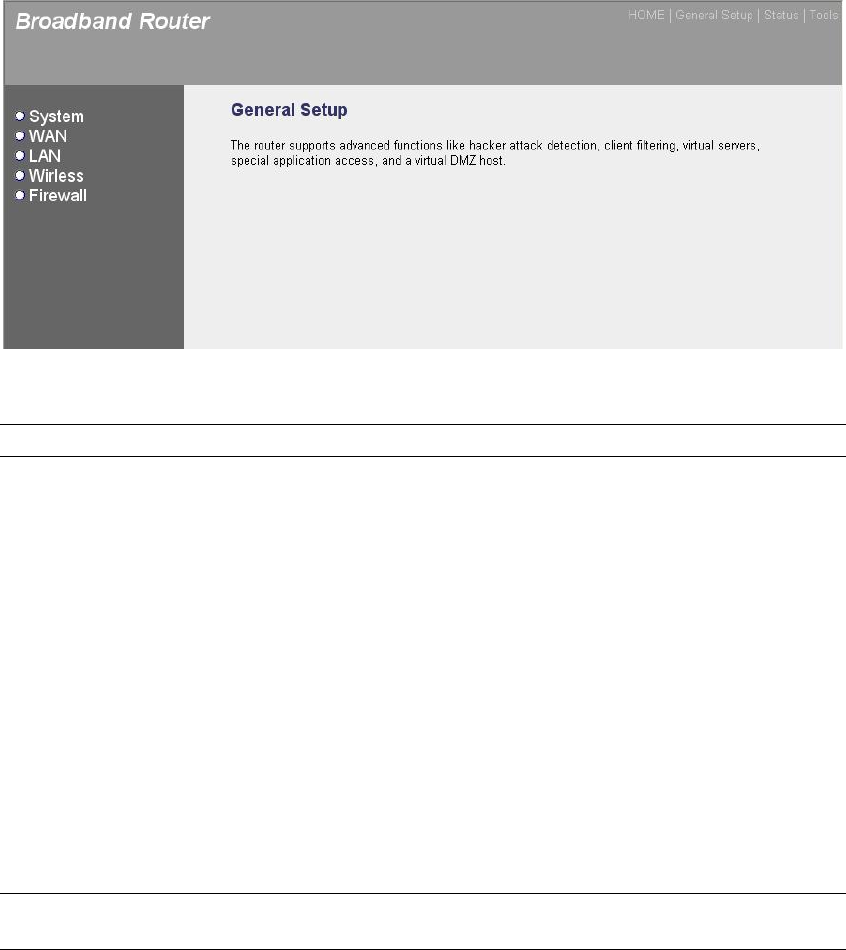
38
Chapter 3
General Settings
Once you click on the General Setup button at the Home Page, you should see the screen below.
If you have already configured the Quick Setup Wizard you do NOT need to configure anything
thing in the General Setup screen for you to start using the Internet.
The General Setup contains advanced features that allow you to configure the router to meet
your network’s needs such as: Wireless, Address Mapping, Access Control, Hacker Attack
Prevention, Special Applications, DMZ and other functions.
Below is a general description of what advance functions are available for this broadband router.
Menu Description
2.1 System This section allows you to set the Broadband router’s system
Time Zone, Password and Remote Management Administrator.
2.2 WAN This section allows you to select the connection method in order
to establish a connection with your ISP (same as the Quick
Setup Wizard section)
2.3 LAN You can specify the LAN segment’s IP address, subnet Mask,
enable/disable DHCP and select an IP range for your LAN
2.4 Wireless You can setup the wireless LAN’s SSID, WEP key, MAC
filtering.
2.5 Firewall The Firewall section allows you to configure Access Control,
Hacker Prevention and DMZ.
Select one of the above five General Setup selections and proceed to the manual’s relevant sub-
section
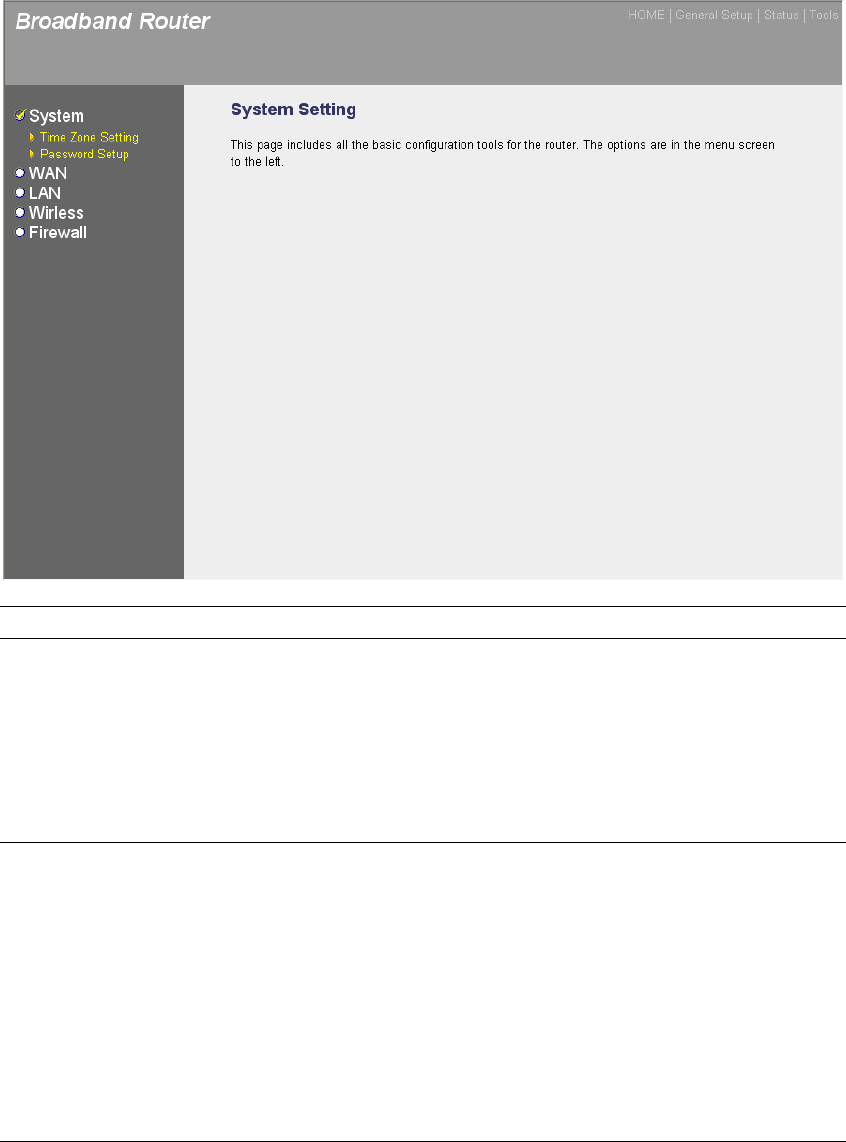
39
3.1 System
The system screen allows you to specify a time zone, to change the system password and to
specify a remote management user for the broadband router.
Parameters Description
System Settings
2.1.1 Time Zone Setting Select the time zone of the country you are currently in.
The router will set its time based on your selection.
2.1.2 Password Setup Allows you to select a password in order to access the
web-based management website.
Select one of the above three system settings selections and proceed to the manual’s relevant
sub-section
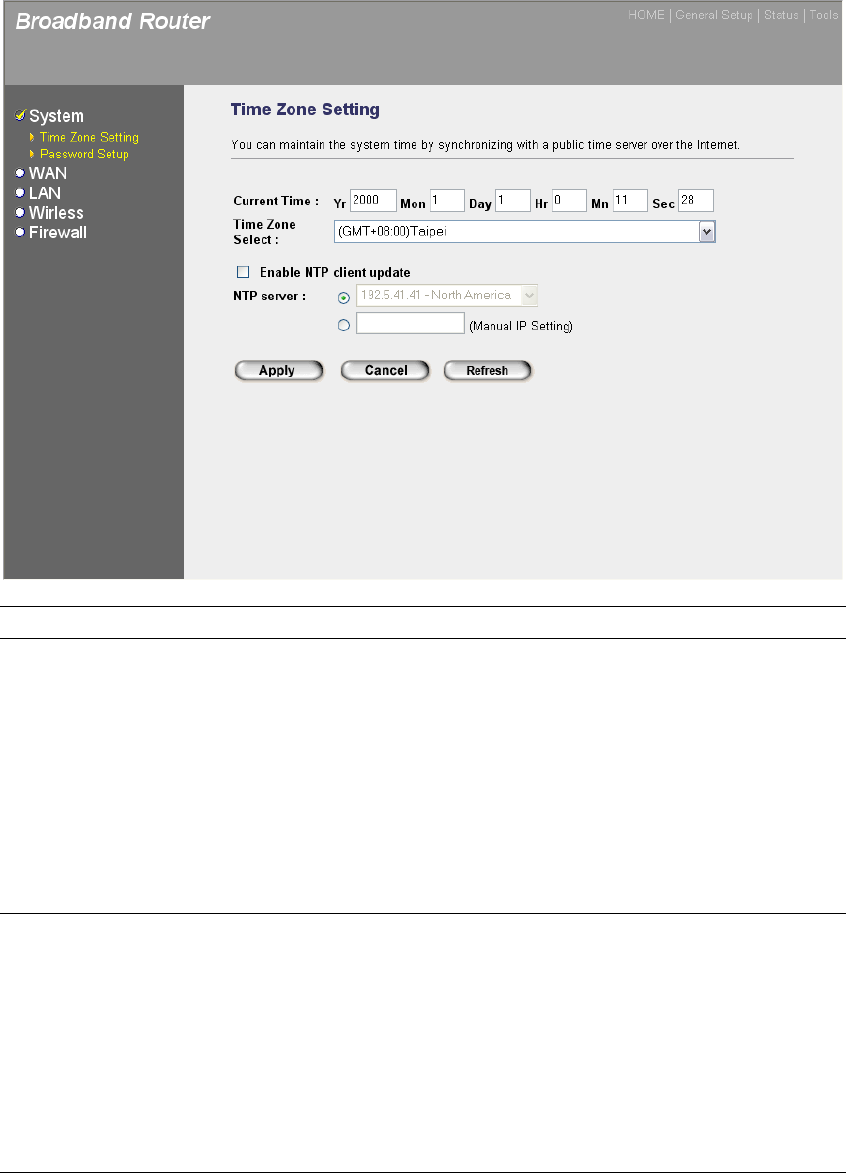
40
3.1.1 Time Zone Setting
The Time Zone Setting allows your router to reference or base its time on the settings configured
here, which will affect functions such as Log entries and Firewall settings.
Parameter Description
Current Time Set the current time.
Time Zone Select Select the time zone of the country you are currently in.
The router will set its time based on your selection.
Enable NTP client update Check the box to enable router to update time from NTP
server.
NTP Server Select one preset time server or manual input a server
IP.
Click <Apply> at the bottom of the screen to save the above configurations. You can now
configure other advance sections or start using the router (with the advance settings in place)
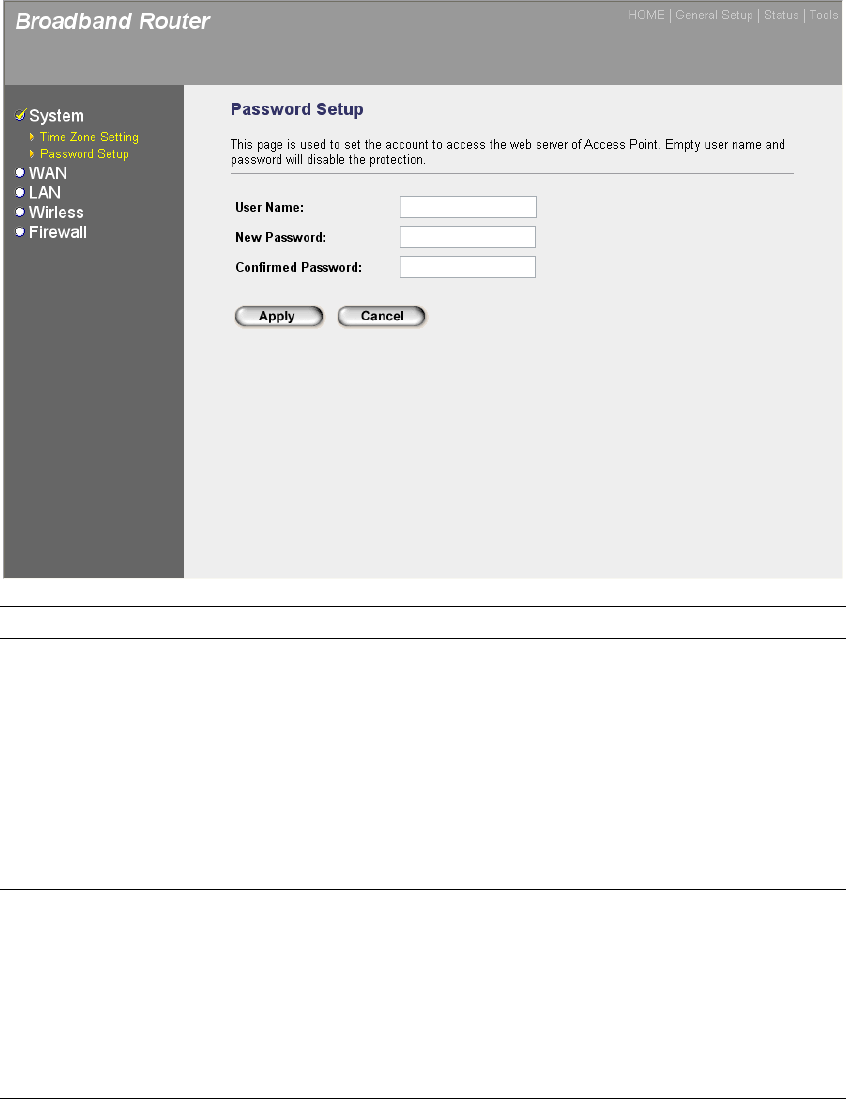
41
3.1.2 Password Setup
You can change the password required to log into the broadband router's system web-based
management. By default, there is no password. So please assign a password to the Administrator
as soon as possible, and store it in a safe place. Passwords can contain 0 to 12 alphanumeric
characters, and are case sensitive.
Parameters Description
User Name Change your login user name.
New Password Enter your new password
Confirmed Password Enter your new password again for verification purposes
Note: If you forget your password, you’ll have to reset the router
to the factory default (No password) with the reset button (see
router’s back panel)
Click <Apply> at the bottom of the screen to save the above configurations. You can now
configure other advance sections or start using the router (with the advance settings in place)
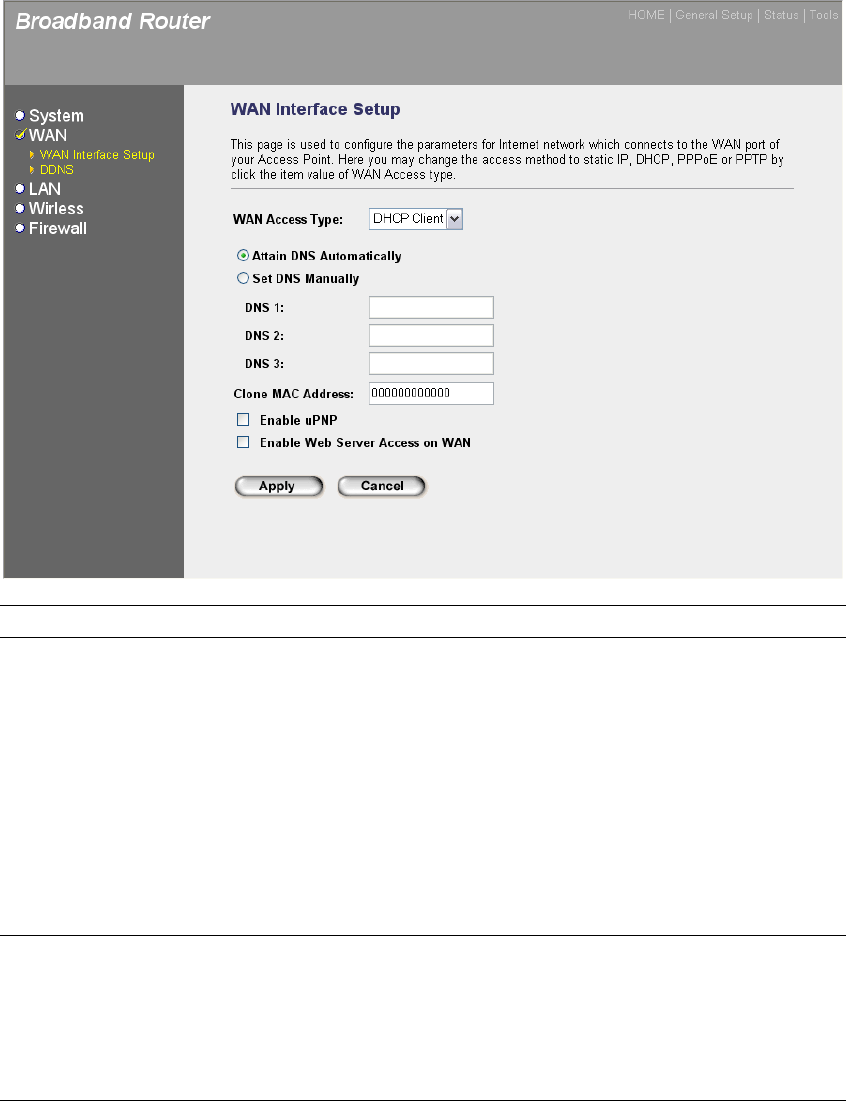
42
3.2 WAN
Use the WAN Settings screen if you have already configured the Quick Setup Wizard section and
you would like to change your Internet connection type. The WAN Settings screen allows to
specify the type of WAN port connect you want to establish with your ISP. The WAN settings offer
the following selections for the router’s WAN port, Static IP Address, DHCP Client, PPPoE,
PPTP, and DDNS.
Parameters Description
3.2.1 Static IP Your ISP has given you an IP address already.
3.2.2 DHCP Client Your ISP will automatically give you an IP address.
3.2.3 PPPoE Your ISP requires PPPoE connection.
3.2.4 PPTP Your ISP requires you to use a Point-to-Point Tunneling
Protocol (PPTP) connection.
3.2.5 L2TP Your ISP requires L2TP connection.
Once you have made a selection, proceed to the manual’s relevant sub-section

43
3.2.1 Static IP
Select Static IP address if your ISP has given you a specific IP address for you to use. Your ISP
should provide all the information required in this section. (See chapter 1 “Static IP” for more
detail)
3.2.2 DHCP Client
Choose the Dynamic IP selection if your ISP will automatically give you an IP address. Some
ISP’s may also require that you fill in additional information such as Host Name, Domain Name
and MAC address (see chapter 1 “DHCP Client” for more detail)
3.2.3 PPPoE (PPP over Ethernet)
Select PPPoE if your ISP requires the PPPoE protocol to connect you to the Internet. Your ISP
should provide all the information required in this section. (See chapter 1 “PPPoE” for more detail)
3.2.4 PPTP
Select PPTP if your ISP requires the PPTP protocol to connect you to the Internet. Your ISP
should provide all the information required in this section. (See chapter 1 “PPTP” for more detail)
3.2.5 L2TP
Select L2TP if your ISP requires the L2TP protocol to connect you to the Internet. Your ISP
should provide all the information required in this section. (See chapter 1 “L2TP” for more detail)
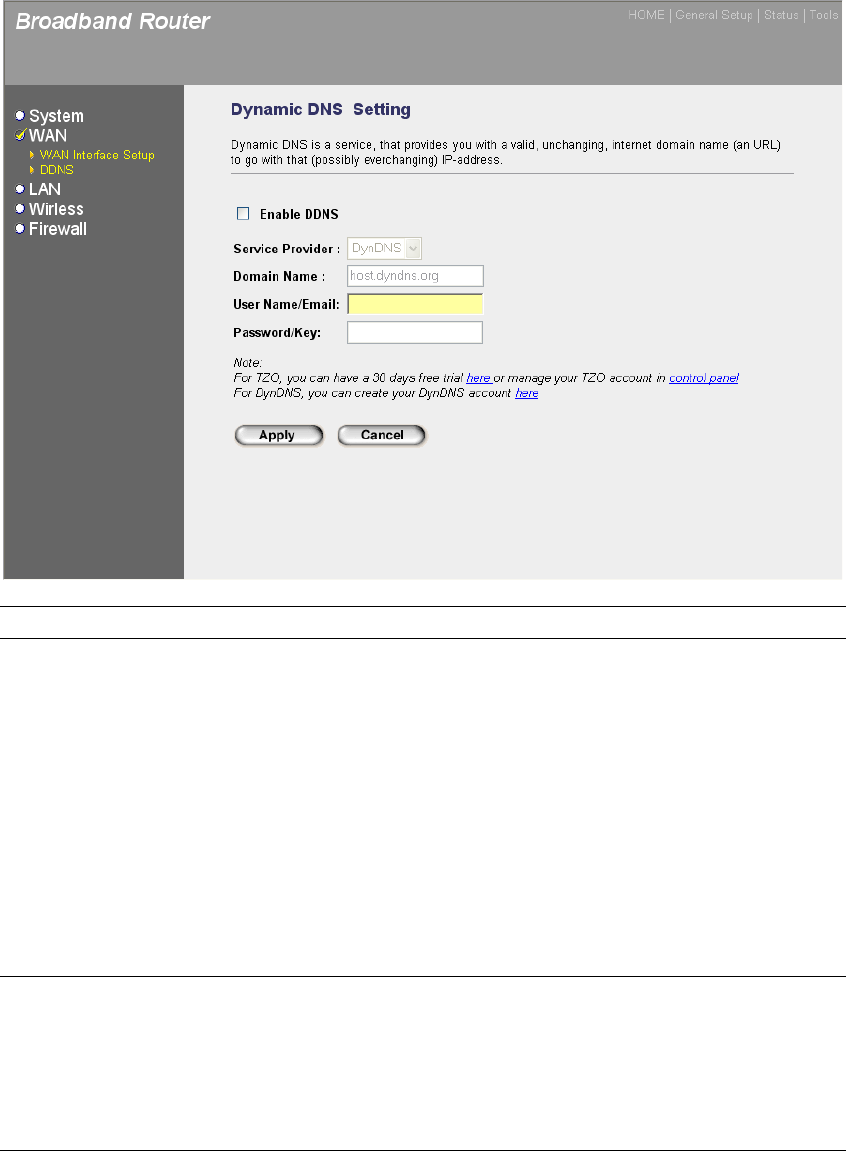
44
3.2.6 DDNS
DDNS allows you to map the static domain name to a dynamic IP address. You must get an
account, password and your static domain name from the DDNS service providers. This router
supports DynDNS, and TZO.
Parameters Default Description
Enable DDNS Disable Enable/Disable the DDNS function of this router
Service Provider Select a DDNS service provider
Domain name Your static domain name that use DDNS
User Name/Email The account that your DDNS service provider
assigned to you
Password/Key The password you set for the DDNS service
account above
Click <Apply> at the bottom of the screen to save the above configurations. You can now
configure other advance sections or start using the router (with the advance settings in place)
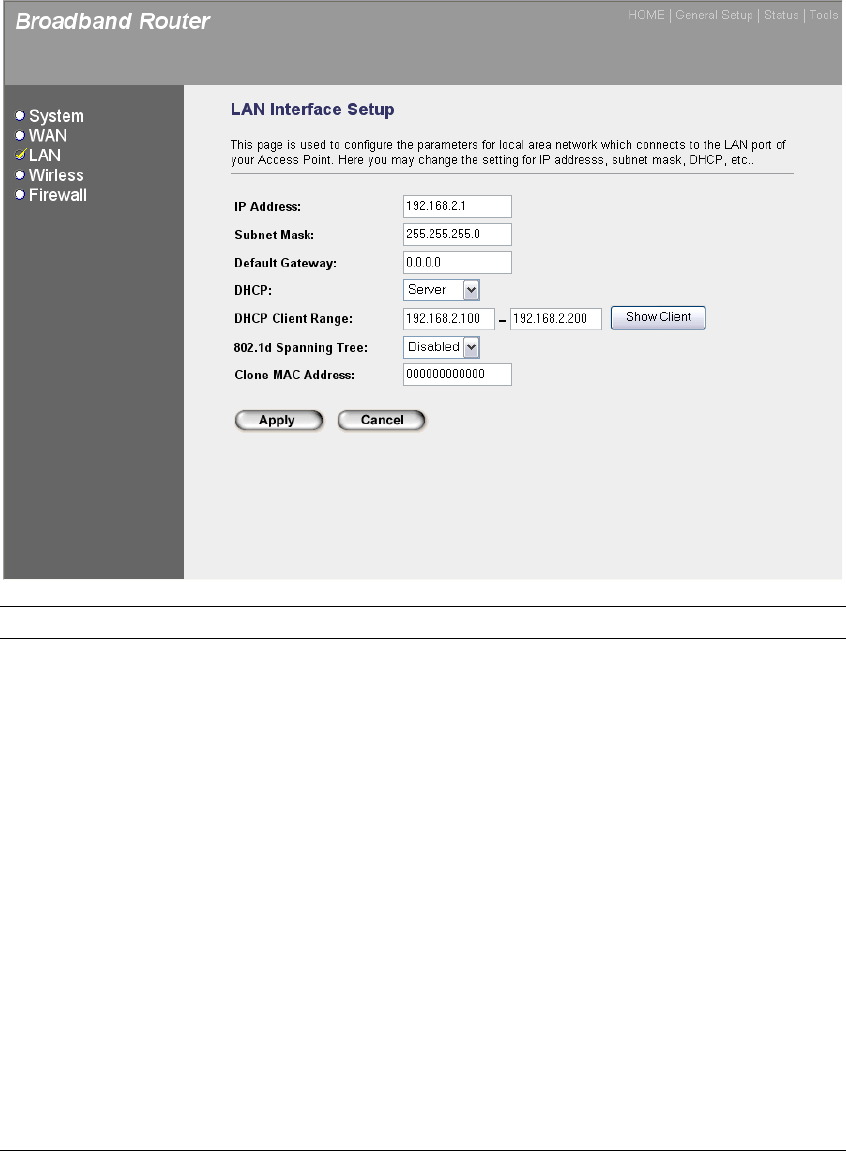
45
3.3 LAN
The LAN Port screen below allows you to specify a private IP address for your router’s LAN ports
as well as a subnet mask for your LAN segment.
Parameters Default Description
IP address 192.168.2.1 This is the router’s LAN port IP address (Your
LAN clients default gateway IP address)
Subnet Mask 255.255.255.0 Specify a Subnet Mask for your LAN segment
Default Gateway Specify the default gateway for LAN
segment.
DHCP Server You can select the DHCP type for LAN segment.
By selecting the DHCP server, the router will
automatically give your LAN clients an IP
address. By selecting the DHCP client, the
router will get an IP address from LAN DHCP
server automatically. If the DHCP server is not
enabled then you’ll have to manually set your
LAN client’s IP addresses; make sure the LAN
Client is in the same subnet as this broadband
router if you want the router to be your LAN
client’s default gateway
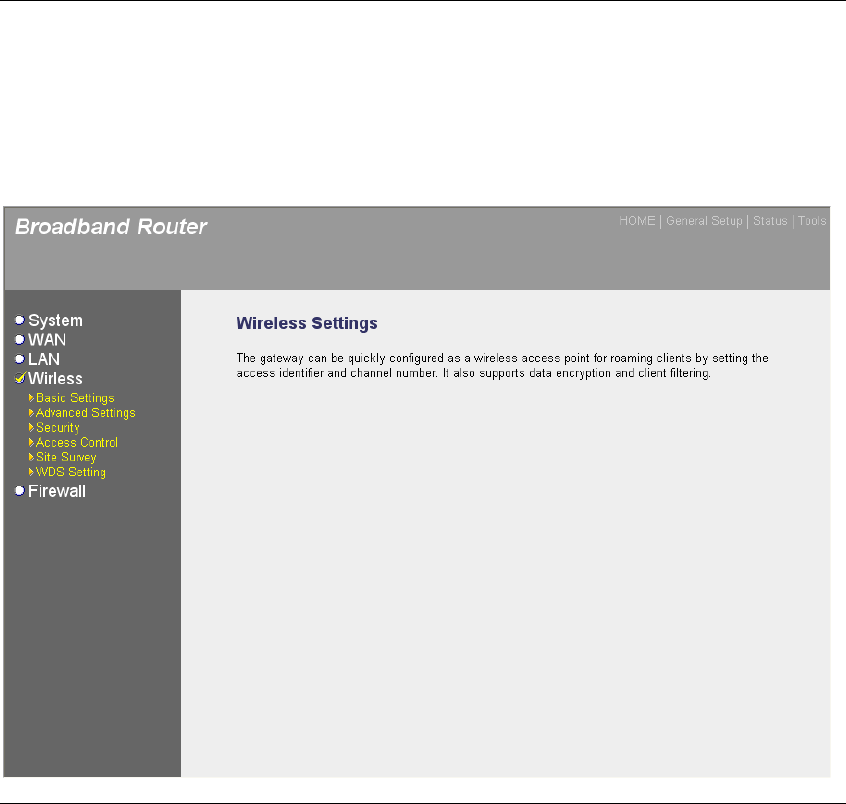
46
DHCP Client Range You can select a particular IP address range for
your DHCP server to issue IP addresses to your
LAN Clients.
Note: By default the IP range is from: Start IP
192.168.2.100 to End IP 192.168.2.199. If you
want your PC to have a static/fixed IP address
then you’ll have to choose an IP address outside
this IP address Pool
802.1d Spanning Tree Disabled If 802.1d Spanning Tree function is enabled, this
router will use the spanning tree protocol to
prevent from network loop happened in the LAN
ports.
Clone MAC Address Specify the MAC Address for your LAN interface.
Click <Apply> at the bottom of the screen to save the above configurations. You can now
configure other advance sections or start using the router (with the advance settings in place)
3.4 Wireless
Wireless Access Point builds a wireless LAN and can let all PCs equipped with IEEE
802.11b or 801.11g wireless network adaptor connect to your Intranet. It supports WEP,
WPA and WPA2 encryption to enhance the security of your wireless network.
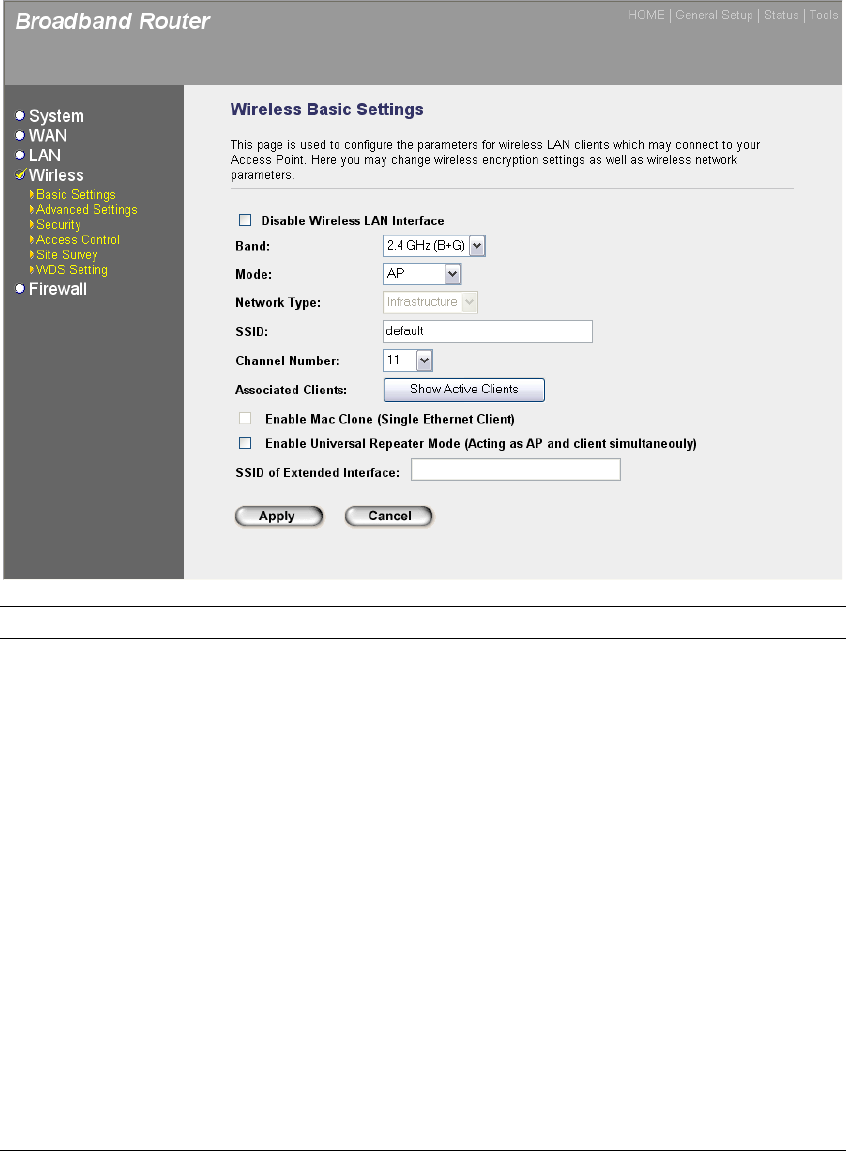
47
3.4.1 Basic Settings
You can set parameters that are used for the wireless stations to connect to this router. The
parameters include Mode, ESSID, Channel Number and Associated Client.
Parameters Default Description
Disable Wireless Check this box to disable wireless LAN.
LAN Interface
Band It allows you to set the AP fix at 802.11b or
802.11g mode. You also can select B+G mode
to allow the AP select 802.11b and 802.11g
connection automatically.
Mode It allows you to set the AP to AP, Client, WDS or
AP+WDS mode.
Network Type You can set the client mode to Infrastructure
or Ad Hoc mode here.
ESSID default This is the name of the wireless LAN. All the
devices in the same wireless LAN should have
the same ESSID.

48
Channel Number 11 The channel used by the wireless LAN. All
devices in the same wireless LAN should
use the same channel.
Associated Clients Click “Show Active Clients” button, then an
“Active Wireless Client Table” will pop up. You
can see the status of all active wireless stations
that are connecting to the access point.
Enable MAC Clone Check the check box will copy the MAC address
of your PC to wireless Interface when the first
packet was received.
Enable Universal By enable the universal repeater mode, the.
Repeater Mode router will act as AP and client simultaneously.
SSID of Extended Set the SSID for the extended wireless interface.
Interface
Click <Apply> at the bottom of the screen to save the above configurations. You can now
configure other advance sections or start using the router (with the advance settings in place)
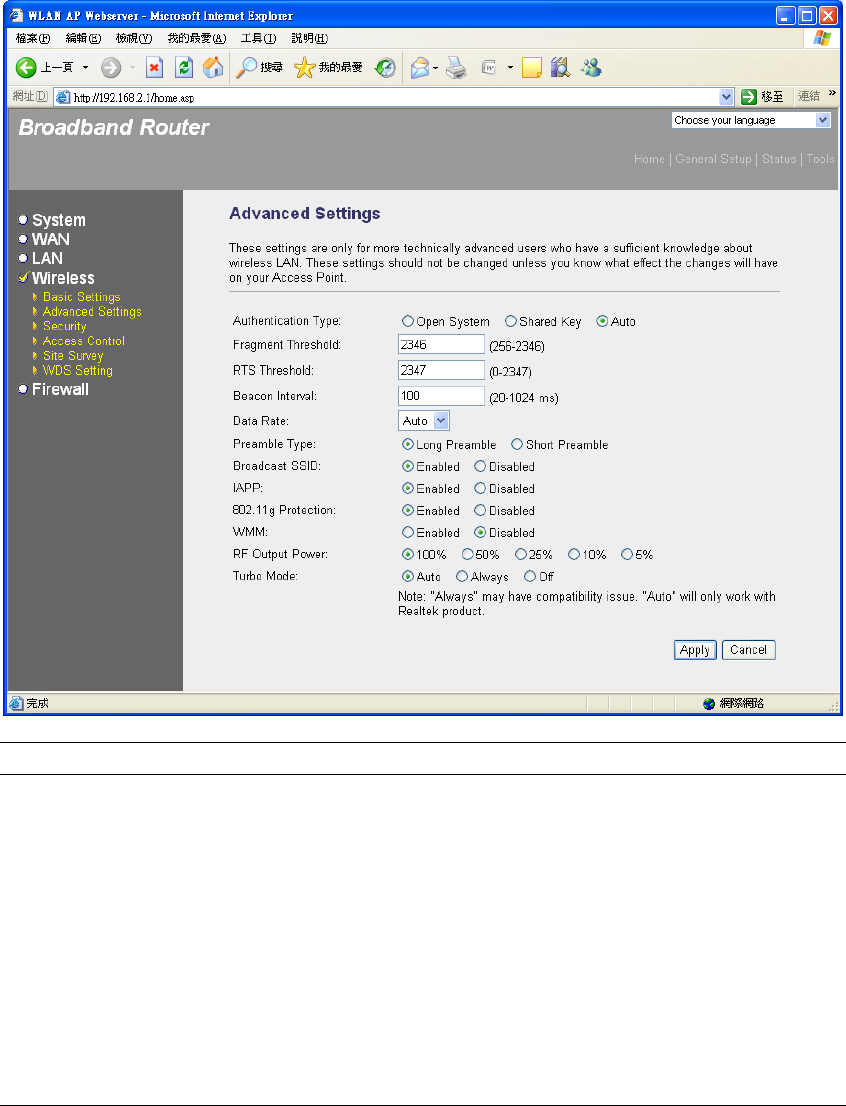
49
3.4.2 Advanced Settings
You can set advanced wireless LAN parameters of this router. The parameters include
Authentication Type, Fragment Threshold, RTS Threshold, Beacon Interval, Preamble
Type …… You should not change these parameters unless you know what effect the
changes will have on this router.
Parameters Default Description
Authentication Type There are two authentication types: "Open
System" and "Shared Key". When you select
"Open System", wireless stations can associate
with this wireless router without WEP encryption.
When you select "Shared Key", you should also
setup WEP key in the "Encryption" page and
wireless stations should use WEP encryption in
the authentication phase to associate with this
wireless router. If you select "Auto", the wireless
client can associate with this wireless router by
using any one of these two authentication types.

50
Fragment Threshold "Fragment Threshold" specifies the maximum
size of packet during the fragmentation of data
to be transmitted. If you set this value too low, it
will result in bad performance.
RTS Threshold When the packet size is smaller the RTS
threshold, the wireless router will not use the
RTS/CTS mechanism to send this packet.
Beacon Interval The interval of time that this wireless router
broadcast a beacon. Beacon is used to
synchronize the wireless network.
Data Rate The “Data Rate” is the rate this access point
uses to transmit data packets. The access point
will use the highest possible selected
transmission rate to transmit the data packets.
Preamble Type The “Long Preamble” can provide better
wireless LAN compatibility while the “Short
Preamble” can provide better wireless LAN
performance.
Broadcast ESSID If you enable “Broadcast ESSID”, every wireless
station located within the coverage of this
access point can discover this access point
easily. If you are building a public wireless
network, enabling this feature is recommended.
Disabling “Broadcast ESSID” can provide better
security.
IAPP If you enable “IAPP”, it will allow wireless station
roaming between IAPP enabled access points
within the same wireless LAN.
802.11g Protection This is also called CTS Protection. It is
recommended to enable the protection
mechanism. This mechanism can decrease the
rate of data collision between 802.11b and
802.11g wireless stations. When the protection
mode is enabled, the throughput of the AP will
be a little lower due to many of frame traffic
should be transmitted.
WMM The short of Wi-Fi MultiMedia, it will enhance the
data transfer performance of multimedia
contents when they’re being transferred over
wireless network. If you don’t know what it is /
not sure if you need it, it’s safe to set this
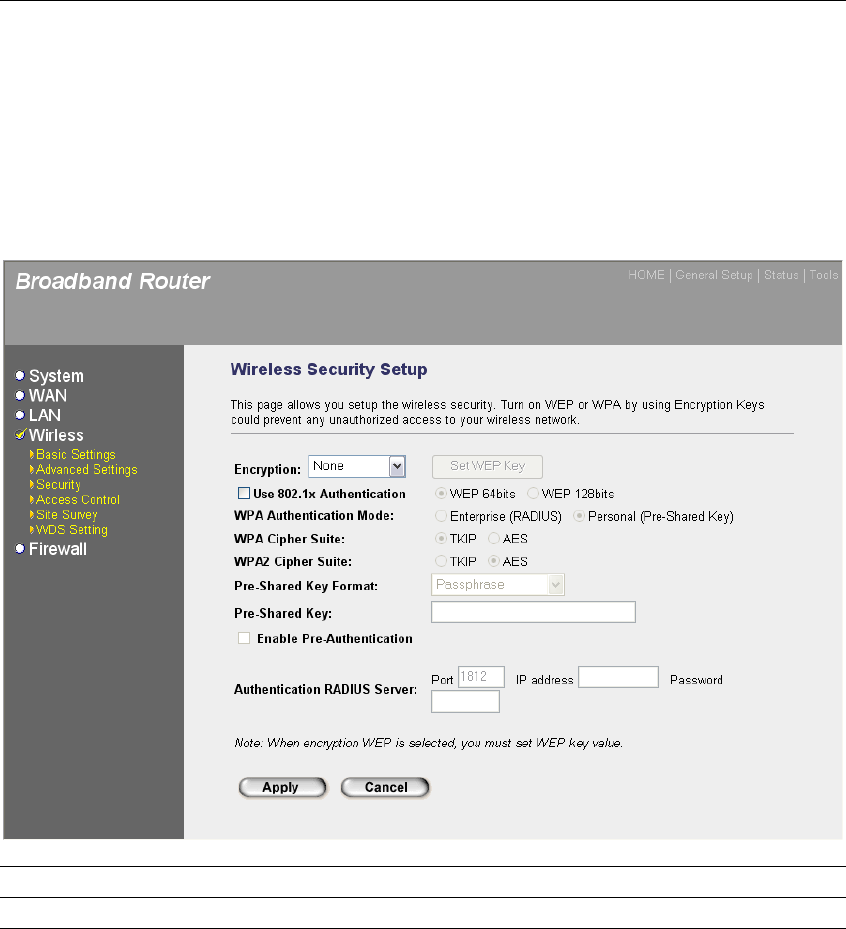
51
option to ‘Enable’, however, default value is
‘Disable’.
RF Output Power You can set the output power of wireless radio.
Unless you’re using this wireless router in a
really big space, you may not have to set output
power to 100%. This will enhance security
(malicious / unknown users in distance will
not be able to reach your wireless router).
Turbo Mode Enhance the data transfer rate of WLAN (up to
35Mbps), default value is ‘Auto’, it’s
recommended to set this option to ‘Auto’.
Click <Apply> at the bottom of the screen to save the above configurations. You can now
configure other advance sections or start using the router.
3.4.3 Security
This Access Point provides complete wireless LAN security functions, include WEP,
IEEE 802.11x, IEEE 802.11x with WEP, WPA with pre-shared key and WPA with
RADIUS. With these security functions, you can prevent your wireless LAN from illegal
access. Please make sure your wireless stations use the same security function.
Parameters Default Description

52
Encryption You can choose no encryption, WEP, WPA,
WPA2 or WPA2 mixed mode for security.
Use 802.1x Authentication IEEE 802.1x is an authentication protocol. Every
user must use a valid account to login to this
Access Point before accessing the wireless LAN.
The authentication is processed by a RADIUS
server. Check this box to authenticates user by
IEEE 802.1x.
Key Length WEP 64-bit You can select the WEP key length for
encryption, 64-bit or 128-bit. Larger WEP key
length will provide higher level of security, but
the throughput will be lower.
WPA Authentication WPA can authenticate by RADIUS or by
Mode pre-shared key.
WPA/WPA2 Cipher You can choose TKIP or AES for WPA/WPA2
key exchange method.
Pre-shared Key Format You may select to select Passphrase
(alphanumeric format) or Hexadecimal Digits (in
the “A-F”, “a-f” and “0-9” range) to be the Pre-
shared Key. For example:
Passphrase: iamguest
Hexadecimal Digits: 12345abcde
Pre-shared Key The Pre-shared key is used to authenticate and
encrypt data transmitted in the wireless network.
Fill the text box by following the rules below.
Hex WEP: input 64-digit Hex values (in the “A-F”,
“a-f” and “0-9” range) or at least 8 character
pass phrase as the pre-shared keys.
Radius Server Port The service port of the external RADIUS server.
Radius Server IP The IP address of external RADIUS server.
Radius Server Password The password used by external RADIUS server.
Click <Apply> at the bottom of the screen to save the above configurations. You can now
configure other advance sections or start using the router (with the advance settings in place)
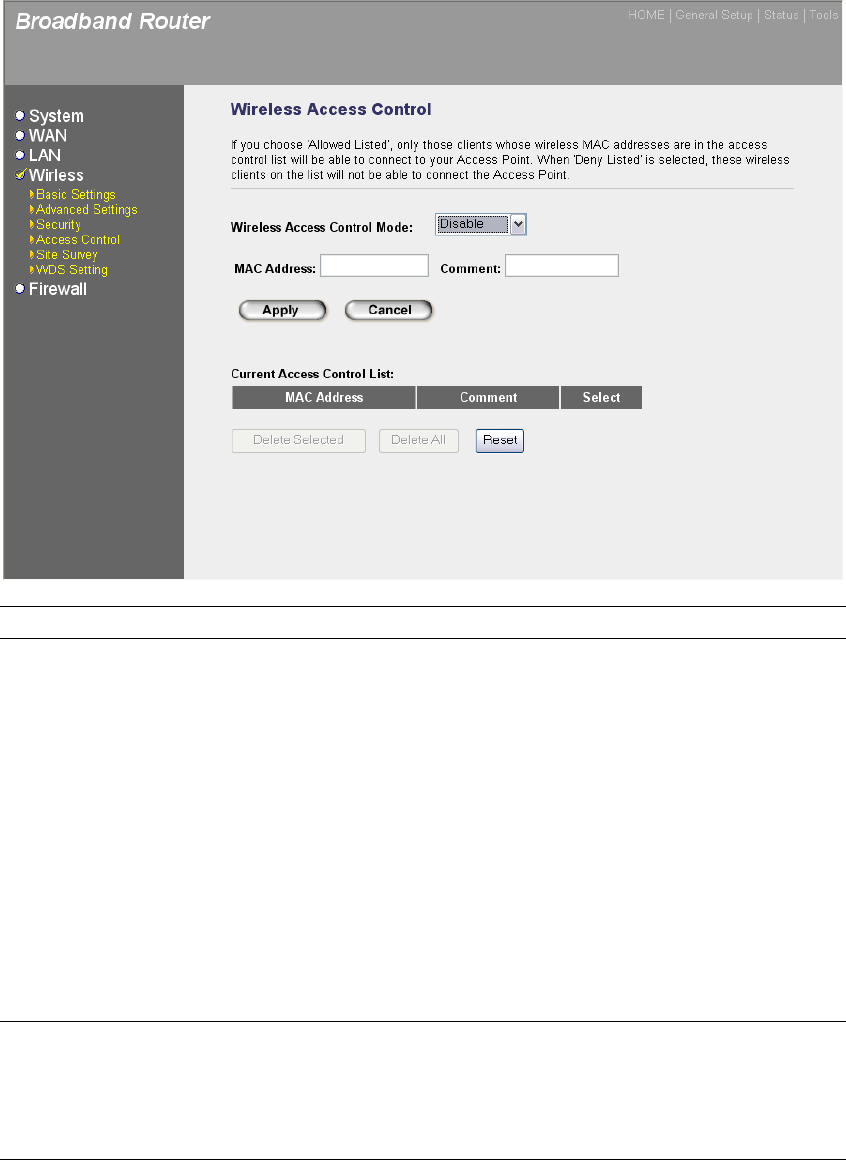
53
3.4.4 Access Control
This wireless router provides MAC Address Control, which prevents the unauthorized
MAC Addresses from accessing your wireless network.
Parameters Description
Wireless Access Control Mode Enable/Disable wireless access control
Add MAC address into the list Fill in the "MAC Address" and "Comment" of the
wireless station to be added and then click "Add".
Then this wireless station will be added into the
"Current Access Control List" below.
Remove MAC address from the list If you want to remove some MAC address from
the "Current Access Control List ", select the
MAC addresses you want to remove in the list
and then click "Delete Selected". If you want
remove all MAC addresses from the table, just
click "Delete All" button. Click "Reset" will clear
your current selections.
Click <Apply> at the bottom of the screen to save the above configurations. You can now
configure other advance sections or start using the router (with the advance settings in place)
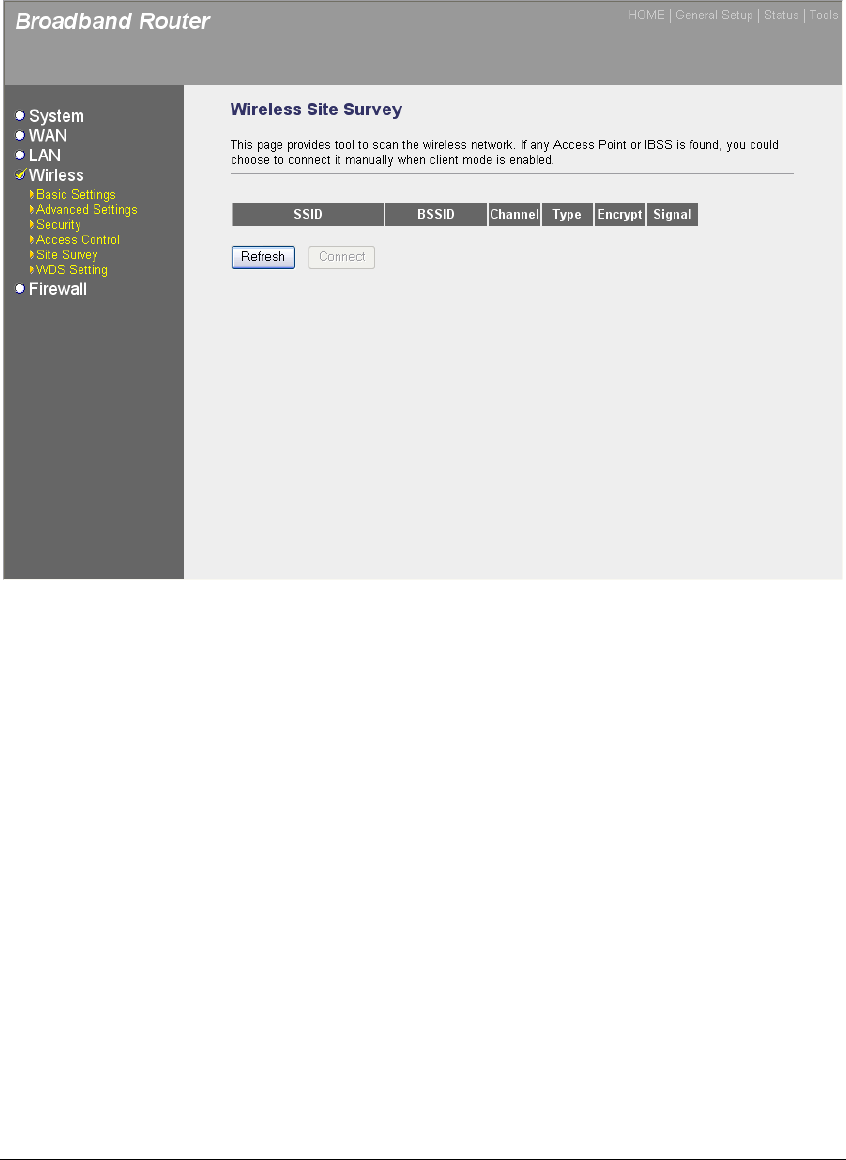
54
3.4.5 Site Survey
This page provides tool to scan the wireless network. If any Access Point or IBSS is
found, you could choose to connect it manually when client mode is enabled.
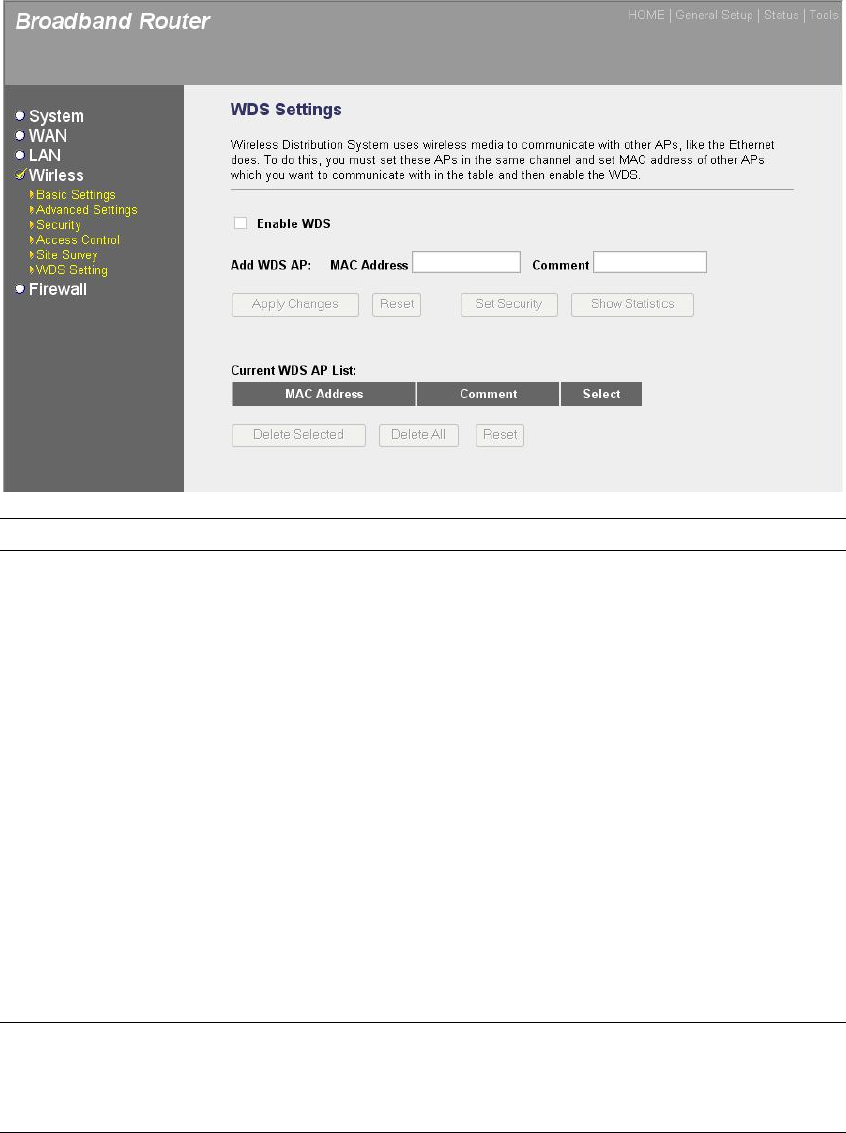
55
3.4.6 WDS Settings
Wireless Distribution System uses wireless media to communicate with other APs, like
the Ethernet does. To do this, you must set these APs in the same channel and set MAC
address of other APs which you want to communicate with in the table and then enable
the WDS.
Parameters Description
Enable WDS Check this box to enable Wireless Distribution
System.
Add WDS AP into the list Fill in the "MAC Address" and "Comment" of the
wireless station to be added and then click
"Apply Changes". Then this wireless AP will be
added into the "Current WDS AP List" below. If
you find any issues before adding it and want to
retype again. Just click "Reset" and both "MAC
Address" and "Comment" fields will be cleared.
Remove WDS AP from the list If you want to remove some AP from the
"Current WDS AP List ", select the MAC
addresses you want to remove in the list and
then click "Delete Selected". If you want remove
all MAC addresses from the table, just click
"Delete All" button. Click "Reset" will clear your
current selections.
Click <Apply> at the bottom of the screen to save the above configurations. You can now
configure other advance sections or start using the router (with the advance settings in place)
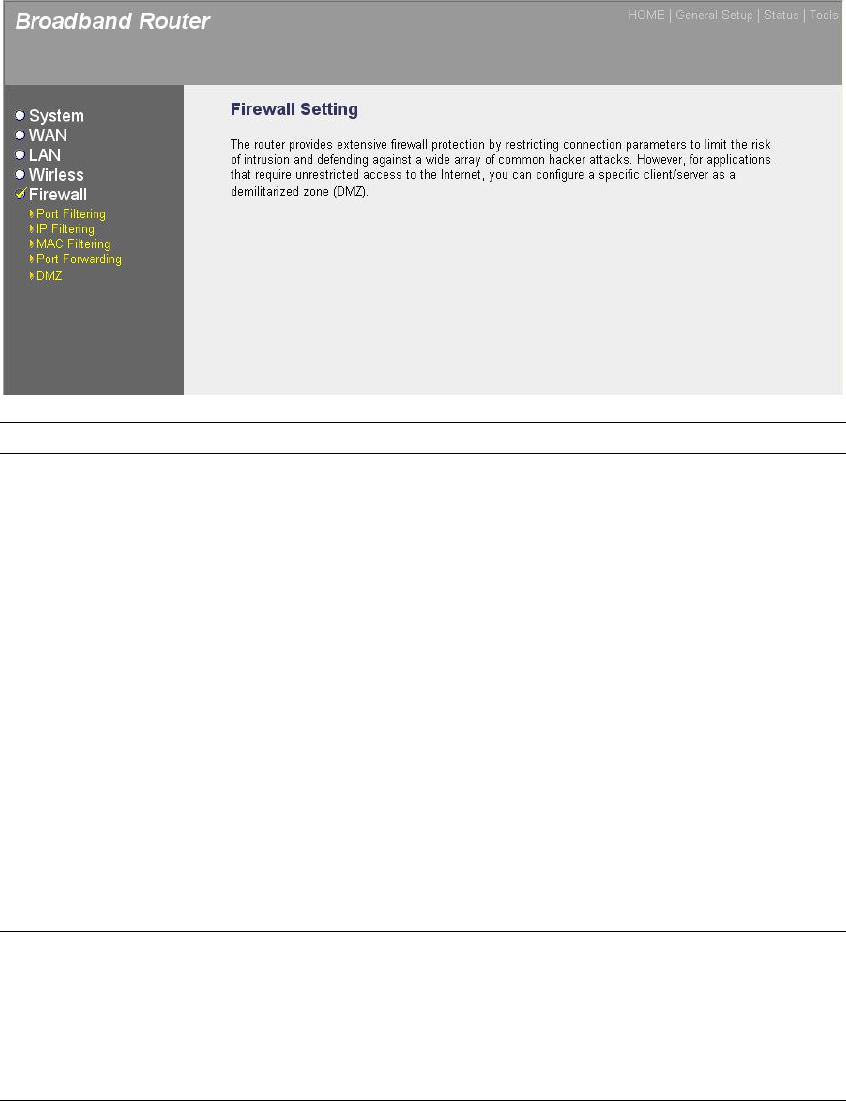
56
3.5 Firewall
The Broadband router provides extensive firewall protection by restricting connection parameters,
thus limiting the risk of hacker attack, and defending against a wide array of common Internet
attacks. However, for applications that require unrestricted access to the Internet, you can
configure a specific client/server as a Demilitarized Zone (DMZ).
Parameters Description
3.5.1 Port Filtering Entries in this table are used to restrict certain types of data
packets from your local network to Internet through the Gateway.
3.5.2 IP Filtering IP Filtering allows you to specify which IP can or can not be used
to access to internet.
3.5.3 MAC Filtering MAC Filtering allows you to specify which MAC Address can or
can not be used to access to internet.
3.5.4 Port Forwarding You can have different services (e.g. email, FTP, Web etc.)
going to different service servers/clients in your LAN. The Port
Forwarding allows you to re-direct a particular range of service
port numbers (from the Internet/WAN Ports) to a particular LAN
IP address.
3.5.5 DMZ The DMZ function allows you to re-direct all packets going to
your WAN port IP address to a particular IP address in your LAN.
Click on one of the firewall selections and proceed to the manual’s relevant sub-section
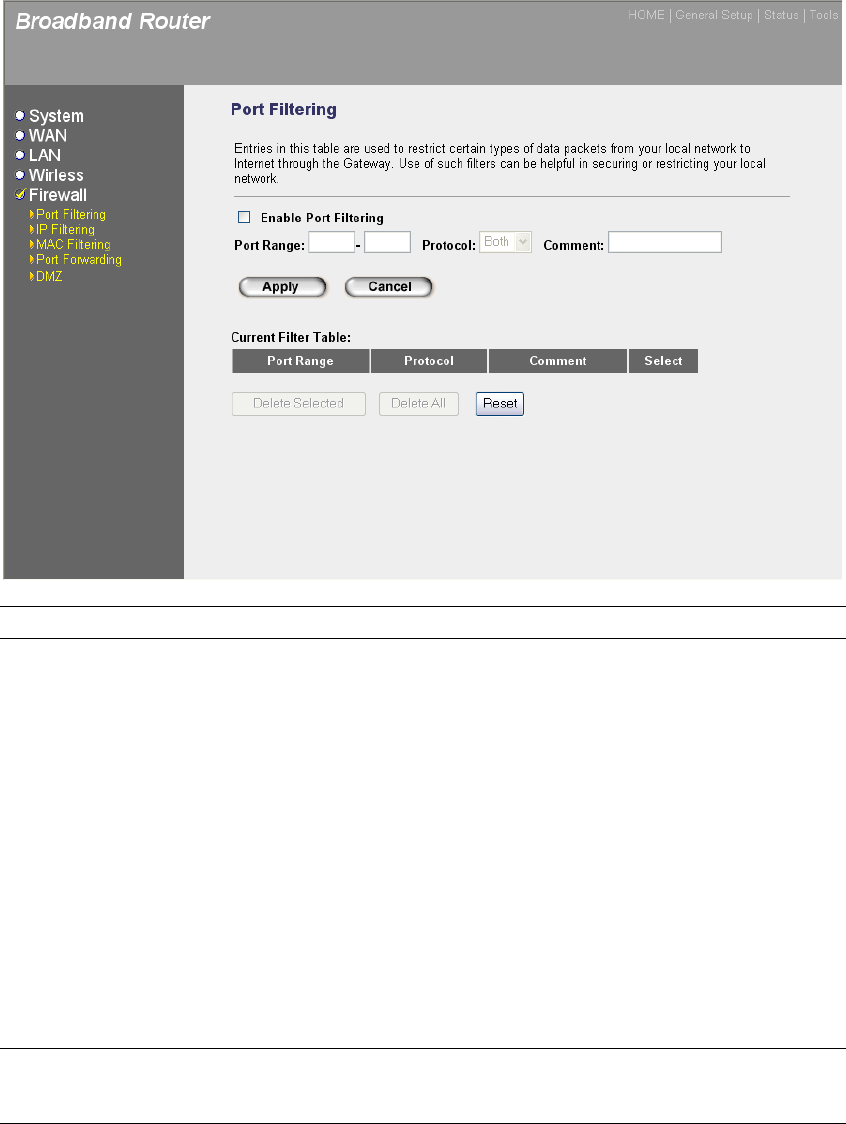
57
3.5.1 Port Filtering
If you want to restrict users from accessing certain Internet applications/services (e.g. Internet
websites, email, FTP etc.), then this is the place to set that configuration. Entries in this table are
used to restrict certain types of data packets from your local network to Internet through the
Gateway. Use of such filters can be helpful in securing or restricting your local network.
Parameters Description
Enable Port Filtering Check this box to enable the port filtering function.
Add a new entry into the list Fill in the "Port Range", "Protocol" and "Comment" of the
filtering rule to be added and then click "Apply ". Then
specified port will be added into the "Current Filter
Table" below. If you find any issues before adding it and
want to retype again. Just click "Cancel" and all inputed
fields will be cleared.
Remove an entry from the list If you want to remove some filter rule from the "Current
Filter Table", select the Port Range you want to remove
in the table and then click "Delete Selected". If you want
remove all Port Ranges from the table, just click "Delete
All" button. Click "Reset" will clear your current
selections.
You can now configure other advance sections or start using the router (with the advance settings
in place)
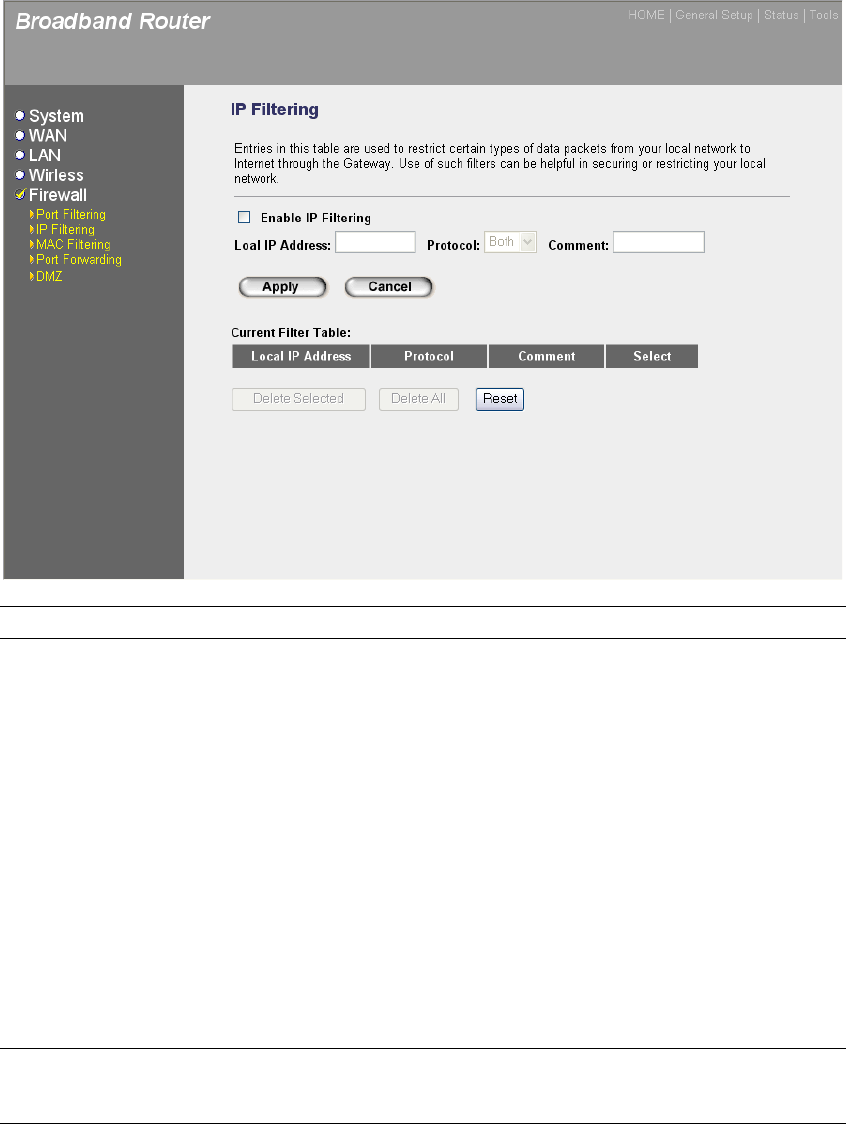
58
3.5.2 IP Filtering
If you want to restrict users from accessing certain Internet applications/services (e.g. Internet
websites, email, FTP etc.), then this is the place to set that configuration. Entries in this table are
used to restrict certain types of data packets from your local network to Internet through the
Gateway. Use of such filters can be helpful in securing or restricting your local network.
Parameters Description
Enable IP Filtering Check this box to enable the IP filtering function.
Add a new entry into the list Fill in the "Local IP Address", "Protocol" and "Comment"
of the filtering rule to be added and then click "Apply ".
Then specified IP will be added into the "Current Filter
Table" below. If you find any issues before adding it and
want to retype again. Just click "Cancel" and all inputed
fields will be cleared.
Remove an entry from the list If you want to remove some filter rule from the "Current
Filter Table", select the Local IP Address you want to
remove in the table and then click "Delete Selected". If
you want remove all Local IP Address from the table,
just click "Delete All" button. Click "Reset" will clear your
current selections.
You can now configure other advance sections or start using the router (with the advance settings
in place)
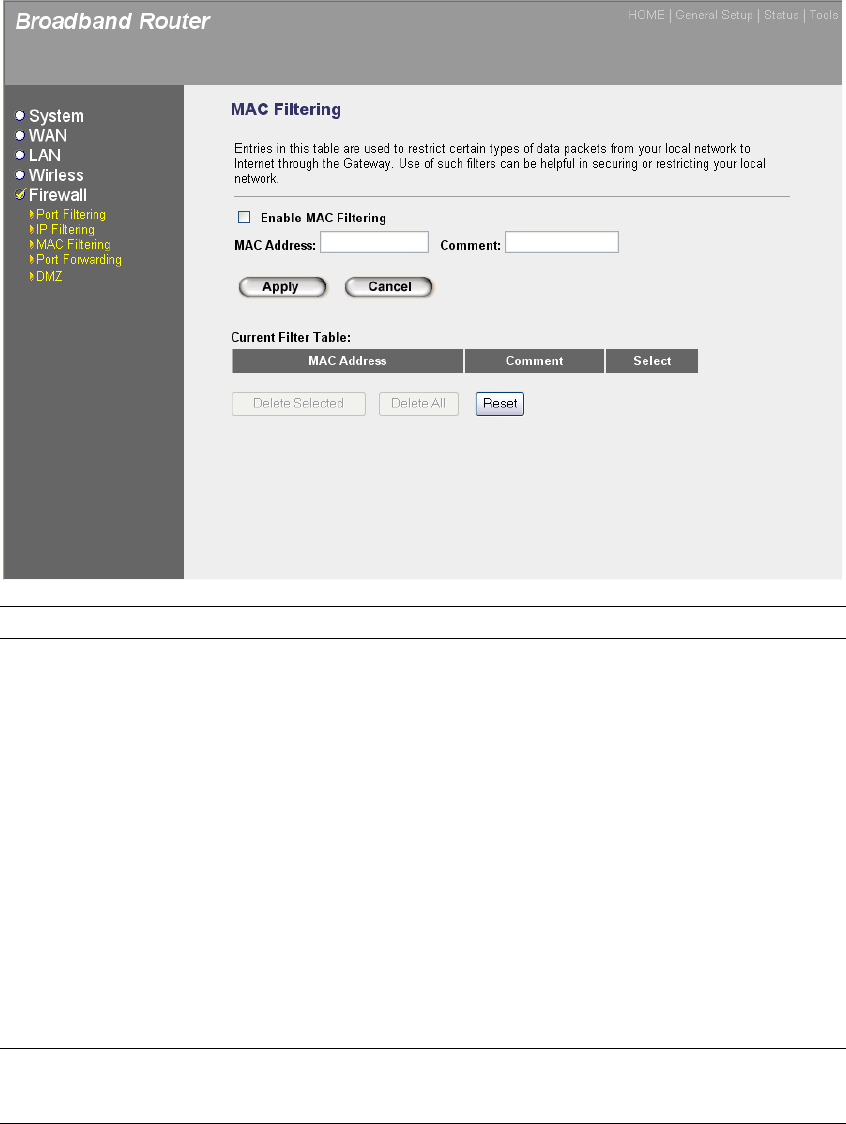
59
3.5.3 MAC Filtering
If you want to restrict users from accessing certain Internet applications/services (e.g. Internet
websites, email, FTP etc.), then this is the place to set that configuration. Entries in this table are
used to restrict certain types of data packets from your local network to Internet through the
Gateway. Use of such filters can be helpful in securing or restricting your local network.
Parameters Description
Enable MAC Filtering Check this box to enable the MAC filtering function.
Add a new entry into the list Fill in the "MAC Address" and "Comment" of the filtering
rule to be added and then click "Apply ". Then specified
MAC will be added into the "Current Filter Table" below.
If you find any issues before adding it and want to retype
again. Just click "Cancel" and all inputed fields will be
cleared.
Remove an entry from the list If you want to remove some filter rule from the "Current
Filter Table", select the MAC Address you want to
remove in the table and then click "Delete Selected". If
you want remove all MAC Address from the table, just
click "Delete All" button. Click "Reset" will clear your
current selections.
You can now configure other advance sections or start using the router (with the advance settings
in place)
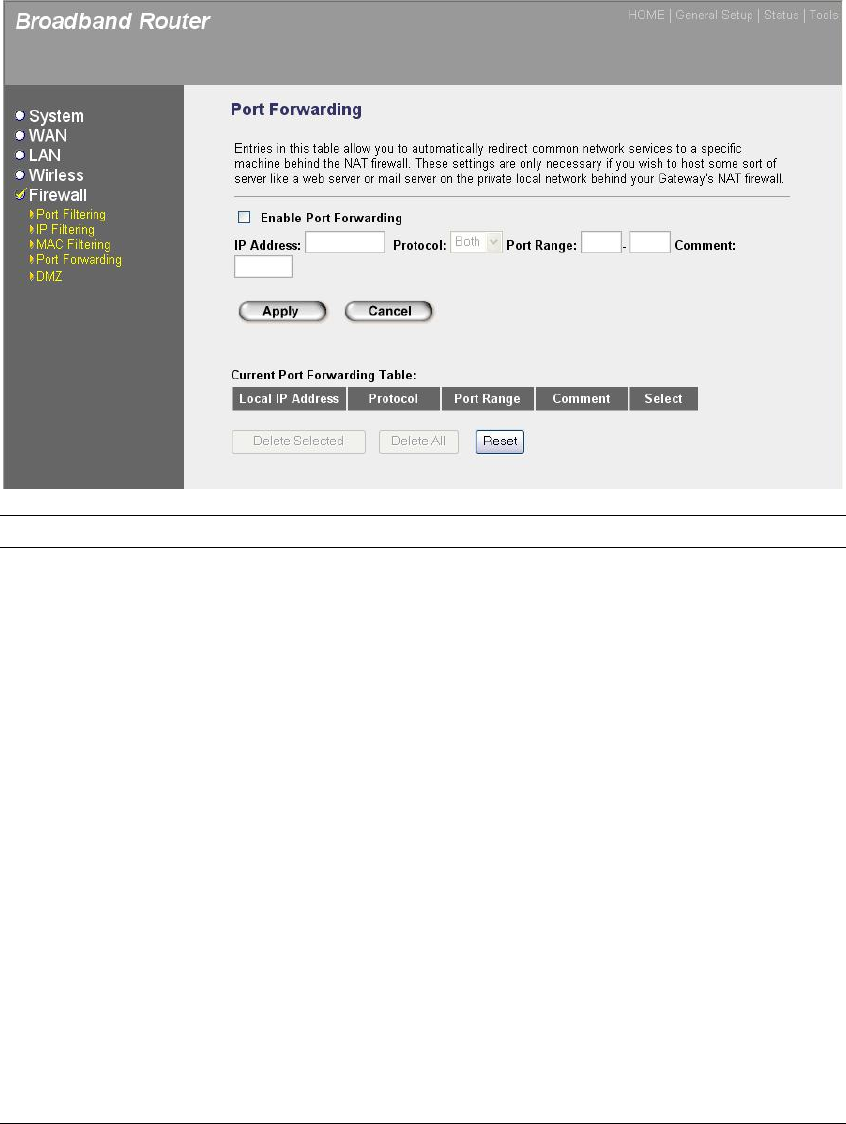
60
3.5.4 Port Forwarding
The Port Forwarding allows you to re-direct a particular range of service port numbers (from the
Internet/WAN Ports) to a particular LAN IP address. It helps you to host some servers behind the
router NAT firewall.
Parameter Description
Enable Port Forwarding Enable Port Forwarding
IP Address This is the private IP of the server behind the
NAT firewall.
Note: You need to give your LAN PC clients a
fixed/static IP address for Port Forwarding to
work properly.
Protocol This is the protocol type to be forwarded. You
can choose to forward “TCP” or “UDP” packets
only or select “both” to forward both “TCP” and
“UDP” packets.
Port Range The range of ports to be forward to the private IP.
Comment The description of this setting.
Add Port Forwarding into the table Fill in the "IP Address", “Protocol”, “Port Range”
and "Comment" of the setting to be added and
then click "Apply". Then this Port Forwarding
setting will be added into the "Current Port
Forwarding Table" below. If you find any typo
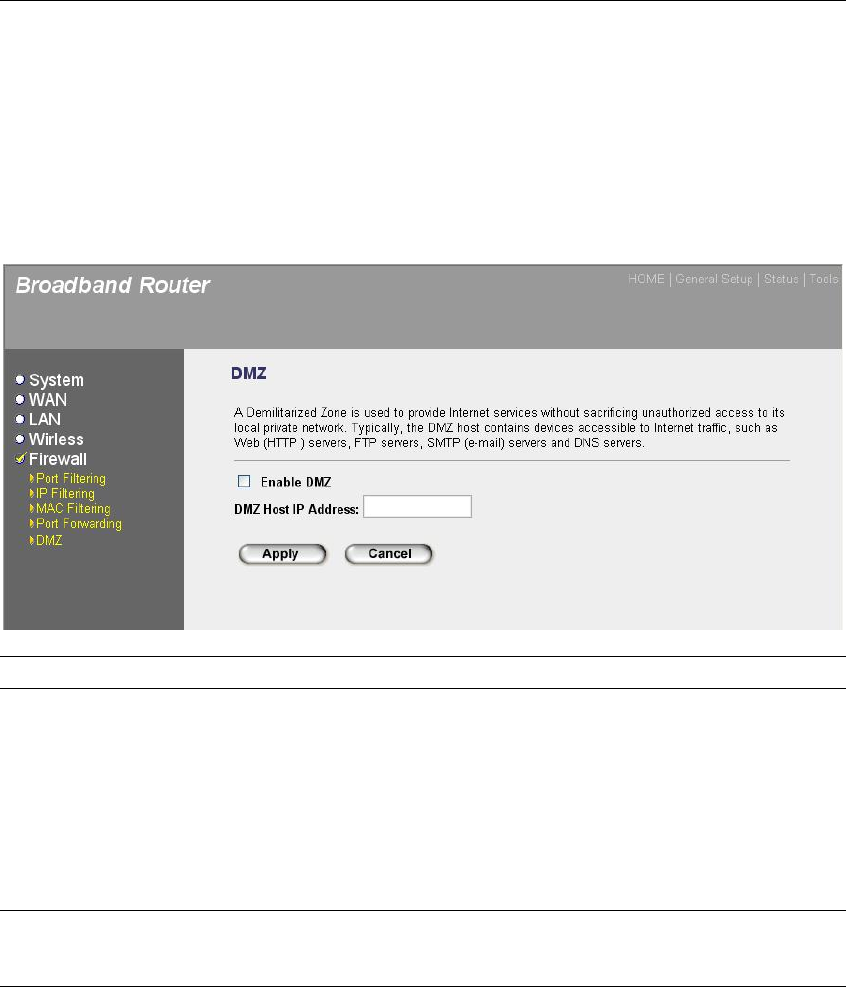
61
before adding it and want to retype again, just
click "Cancel" and the fields will be cleared.
Remove Port Forwarding into the table If you want to remove some Port Forwarding
settings from the "Current Port Forwarding
Table", select the Port Forwarding settings you
want to remove in the table and then click
"Delete Selected". If you want remove all Port
Forwarding settings from the table, just click
"Delete All" button. Click "Reset" will clear your
current selections.
Click <Apply> at the bottom of the screen to save the above configurations. You can now
configure other advance sections or start using the router (with the advance settings in place)
3.5.5 DMZ
If you have a local client PC that cannot run an Internet application (e.g. Games) properly from
behind the NAT firewall, then you can open the client up to unrestricted two-way Internet access
by defining a DMZ Host. The DMZ function allows you to re-direct all packets going to your WAN
port IP address to a particular IP address in your LAN.
Parameters Description
Enable DMZ Enable/disable DMZ
DMZ Host IP Address Input the IP address of a particular host in your LAN that will
receive all the packets originally going to the WAN port/Public IP
address above
Note: You need to give your LAN PC clients a fixed/static IP
address for DMZ to work properly.
You can now configure other advance sections or start using the router (with the advance settings
in place
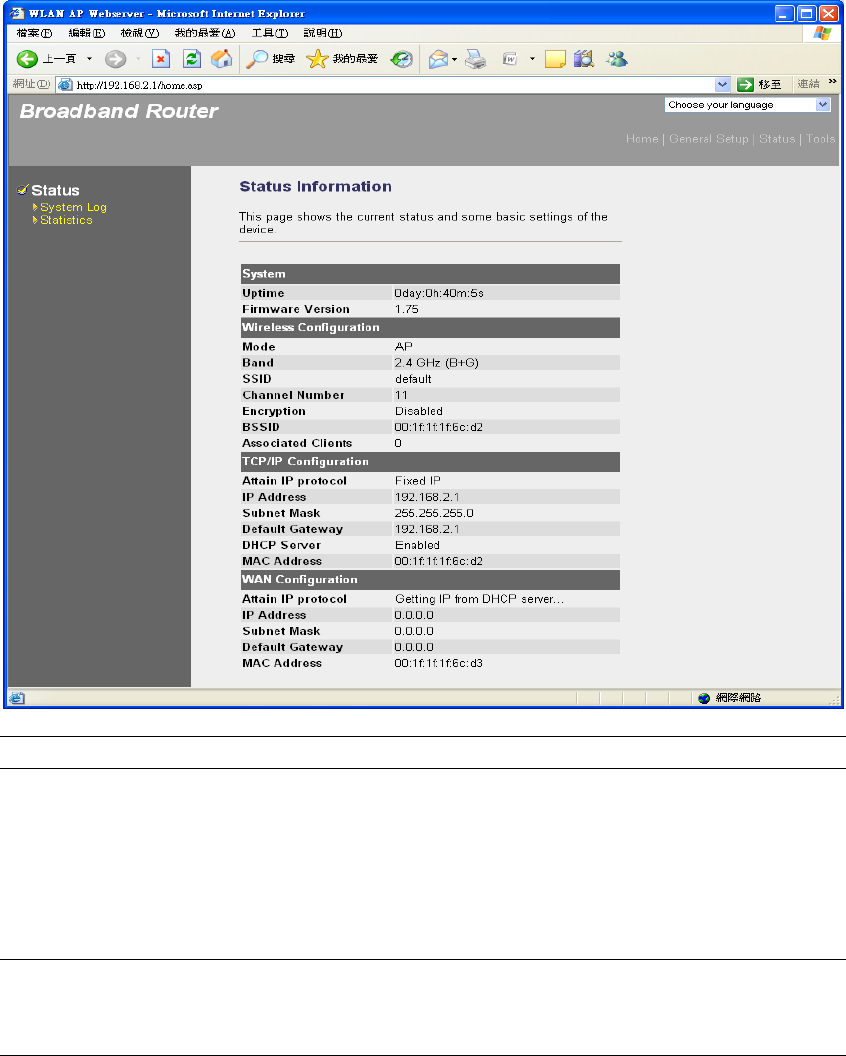
62
Chapter 4
Status
The Status section allows you to monitor the current status of your router. You can use the Status
page to monitor: the connection status of the Broadband router's WAN/LAN interfaces, the
current firmware version numbers, and any illegal attempts to access your network.
Parameters Description
4.1 Status Shows the router’s system information
4.2 System Log View the Broadband router’s system log
4.3 Statistics Shows the statistics
Select one of the above five Status selections and proceed to the manual’s relevant sub-section
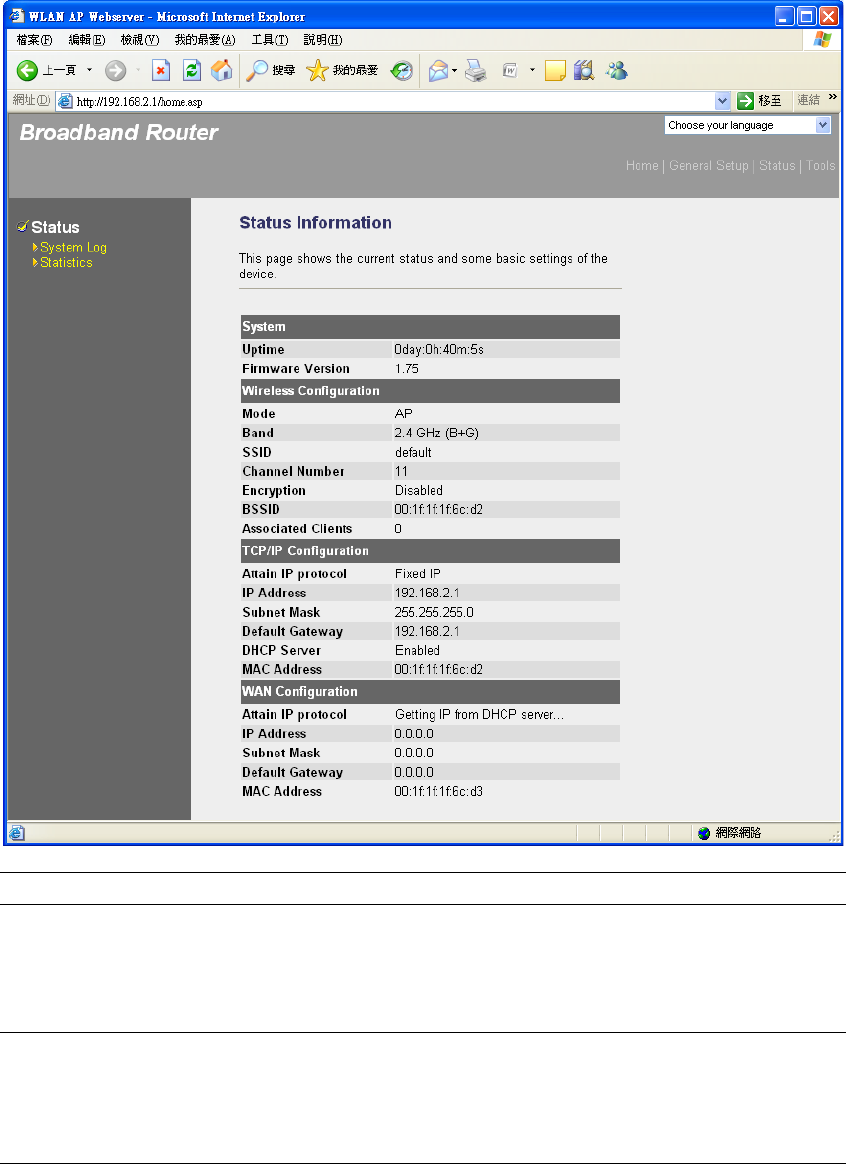
63
4.1 Status
The Status section allows you to view the router’s system information
Parameters Description
Information You can see the router’s system information such as the router’s:
Uptime, Firmware version, Wireless Configuration, LAN Address
information, WAN Configuration information.
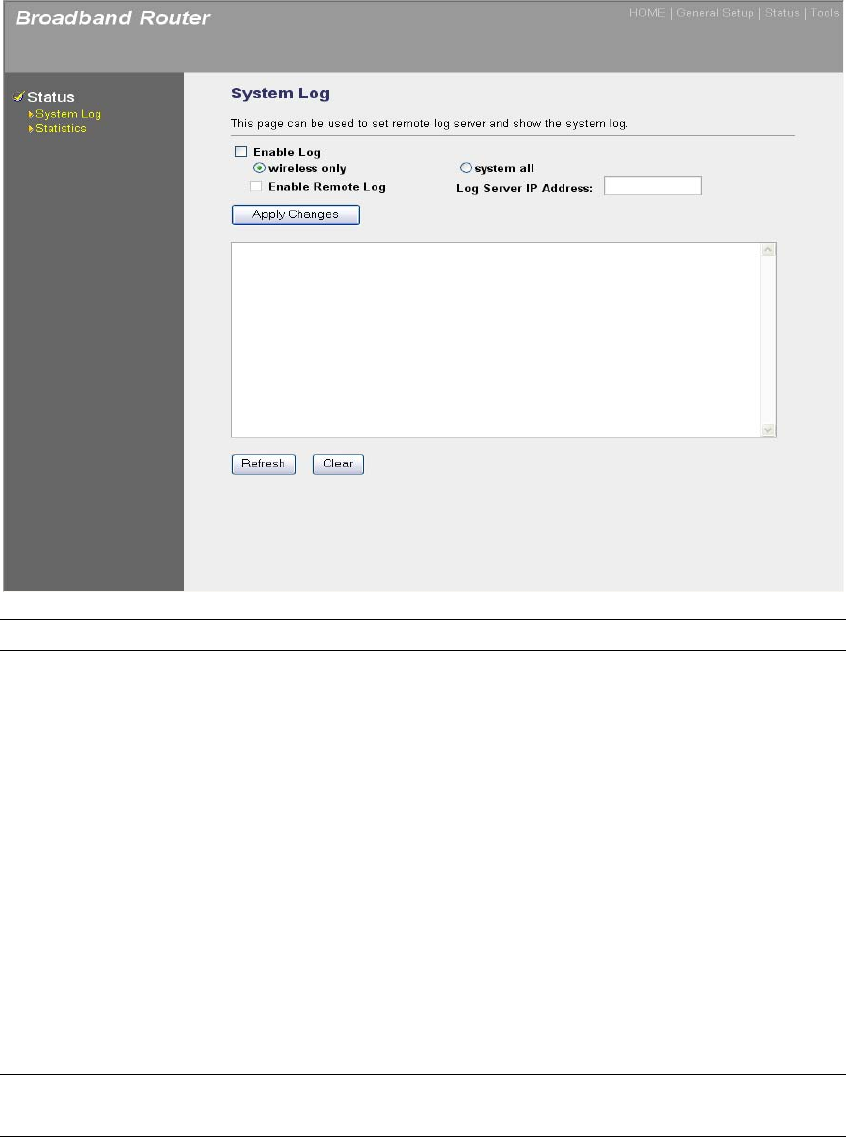
64
4.2 System Log
View the operation log of the system.
Parameters Description
Enable Log Check this box to enable the logging system.
Log mode By select this options, you can have wireless log only or all
system log.
Enable Remote Log If you want to send all log information to remote server, please
check this box to enable this function and fill the server IP
Address in the “Log Server IP Address” field.
System Log This page shows the current system log of the Broadband router.
It displays any event occurred after system start up.
At the bottom of the page, the system log can be cleared
<Clear> or it can be refreshed <Refresh> to get the most
updated situation. When the system is powered down, the
system log will disappear if not saved to a local file.
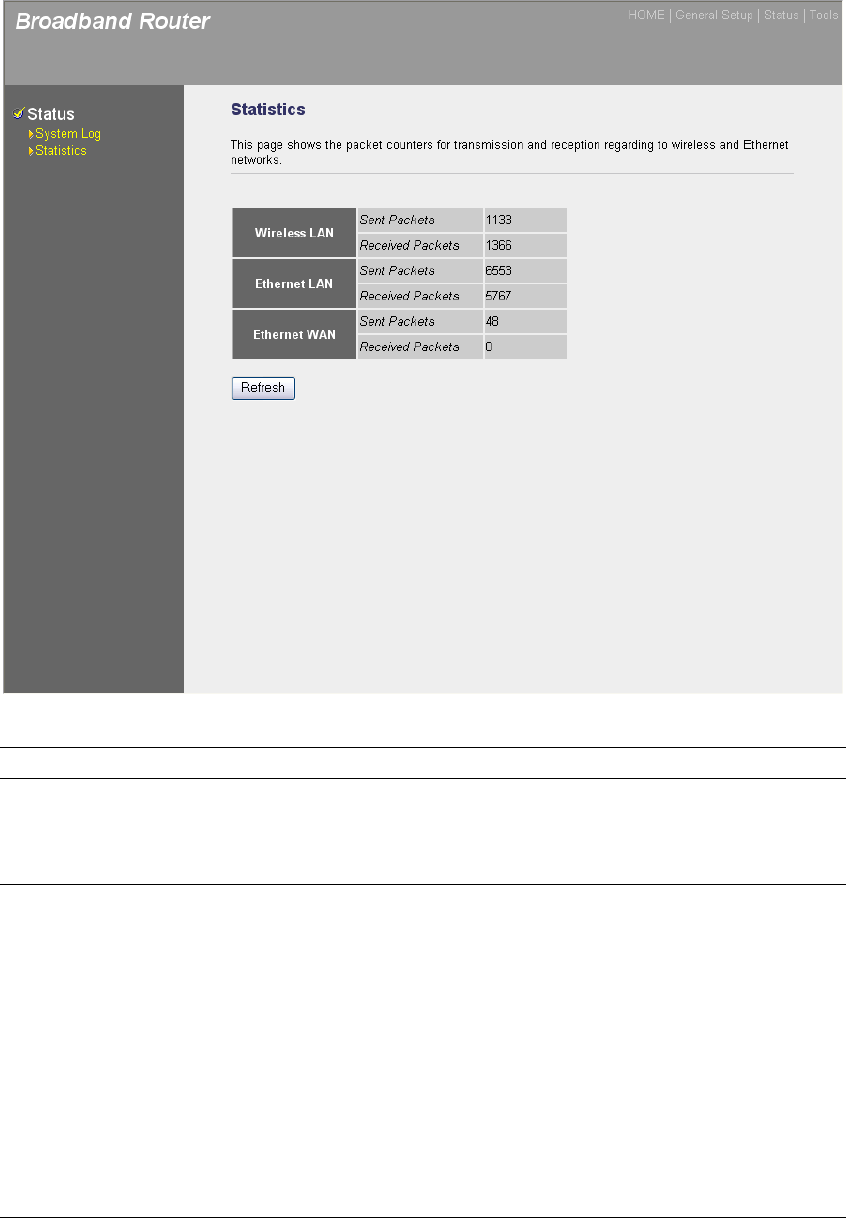
65
4.3 Statistics
View the statistics of packets sent and received on WAN, LAN and Wireless LAN.
Parameters Description
Statistics Shows the counters of packets sent and received on WAN,
LAN and Wireless LAN.
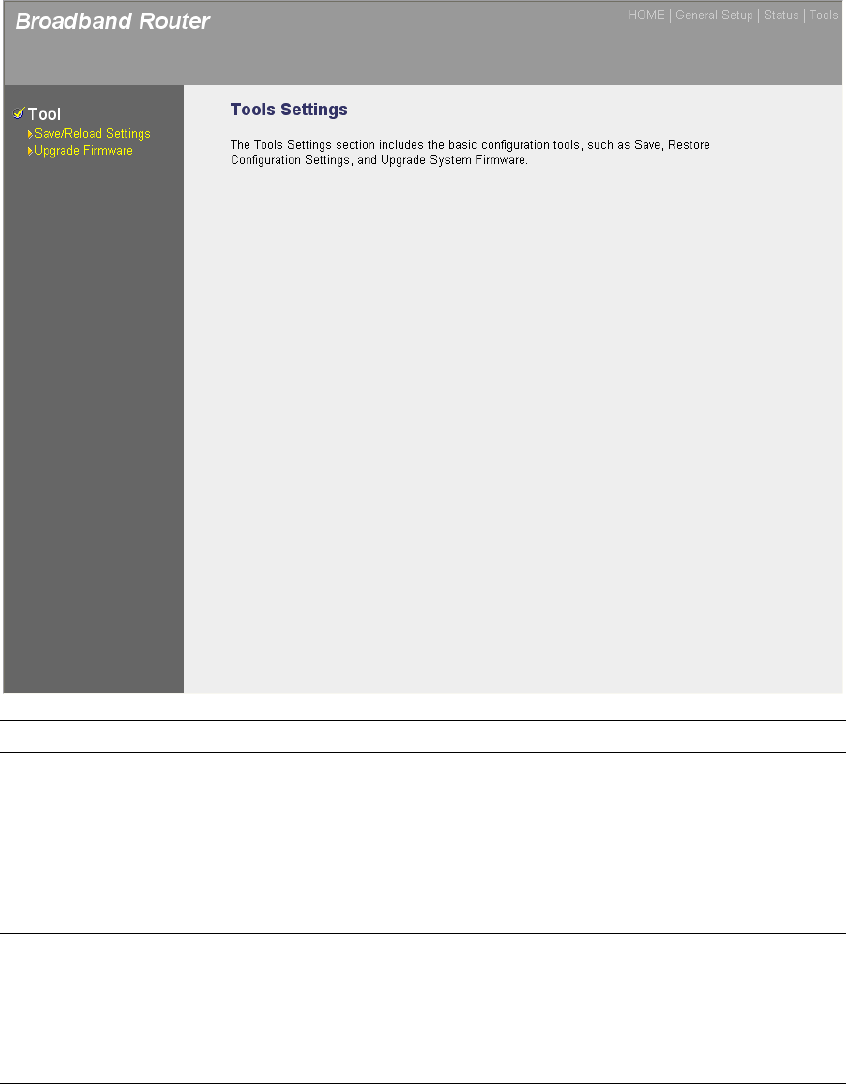
66
Chapter 5
Tool
This page includes the basic configuration tools, such as Configuration Tools (save or restore
configuration settings), Firmware Upgrade (upgrade system firmware) and Reset.
Parameters Description
5.1 Save/Reload Settings You can save the router’s current configuration, restore the
router’s saved configuration files and restore the router’s factory
default settings
5.2 Upgrade Firmware This page allows you to upgrade the router’s firmware
Select one of the above three Tools Settings selection and proceed to the manual’s relevant
sub-section
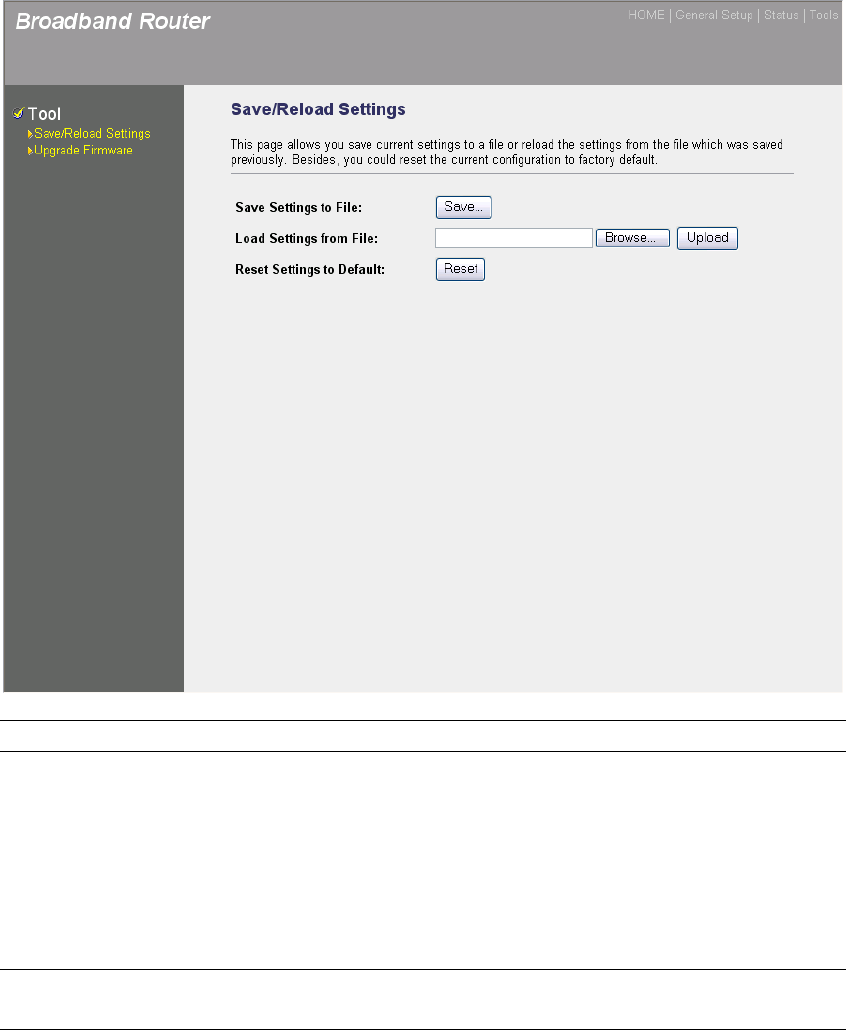
67
5.1 Save/Reload Settings
The Save/Reload Settings screen allows you to save (Backup) the router’s current configuration
setting. Saving the configuration settings provides an added protection and convenience should
problems occur with the router and you have to reset to factory default. When you save the
configuration setting (Backup) you can re-load the saved configuration into the router through the
Restore selection. If extreme problems occur you can use the Restore Settings to Defaults
selection, this will set all configurations to its original default settings (e.g. when you first
purchased the router).
Parameters Description
Configuration Tools Use the "Backup" tool to save the Broadband router current
configuration to a file named "config.bin" on your PC. You can
then use the "Restore" tool to restore the saved configuration to
the Broadband router. Alternatively, you can use the "Restore
Settings to Default" tool to force the Broadband router to
perform a power reset and restore the original factory settings.
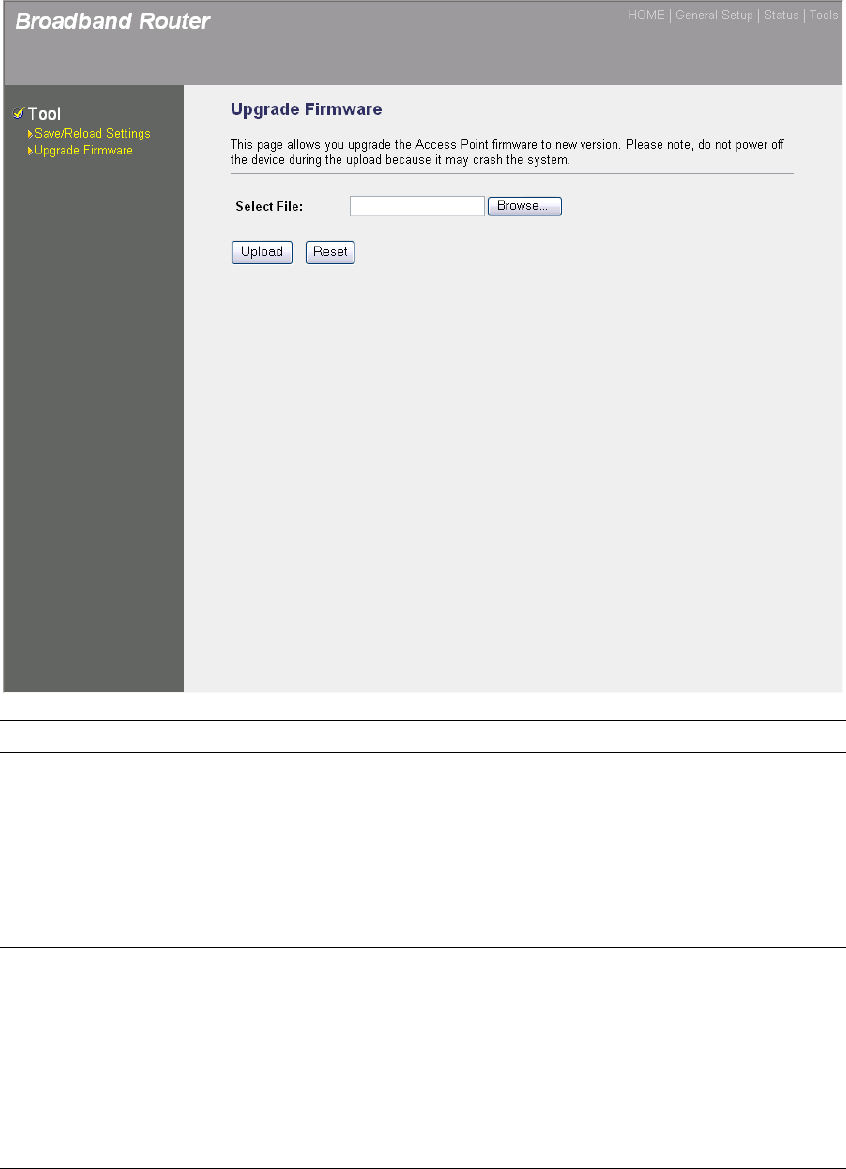
68
5.2 Firmware Upgrade
This page allows you to upgrade the router’s firmware
Parameters Description
Upgrade Firmware This tool allows you to upgrade the Broadband router’s system
firmware. To upgrade the firmware of your Broadband router,
you need to download the firmware file to your local hard disk,
and enter that file name and path in the appropriate field on this
page. You can also use the Browse button to find the firmware
file on your PC.
Once you’ve selected the new firmware file, click <Apply> at the bottom of the screen to start the
upgrade process. (You may have to wait a few minutes for the upgrade to complete). Once the
upgrade is complete you can start using the router.
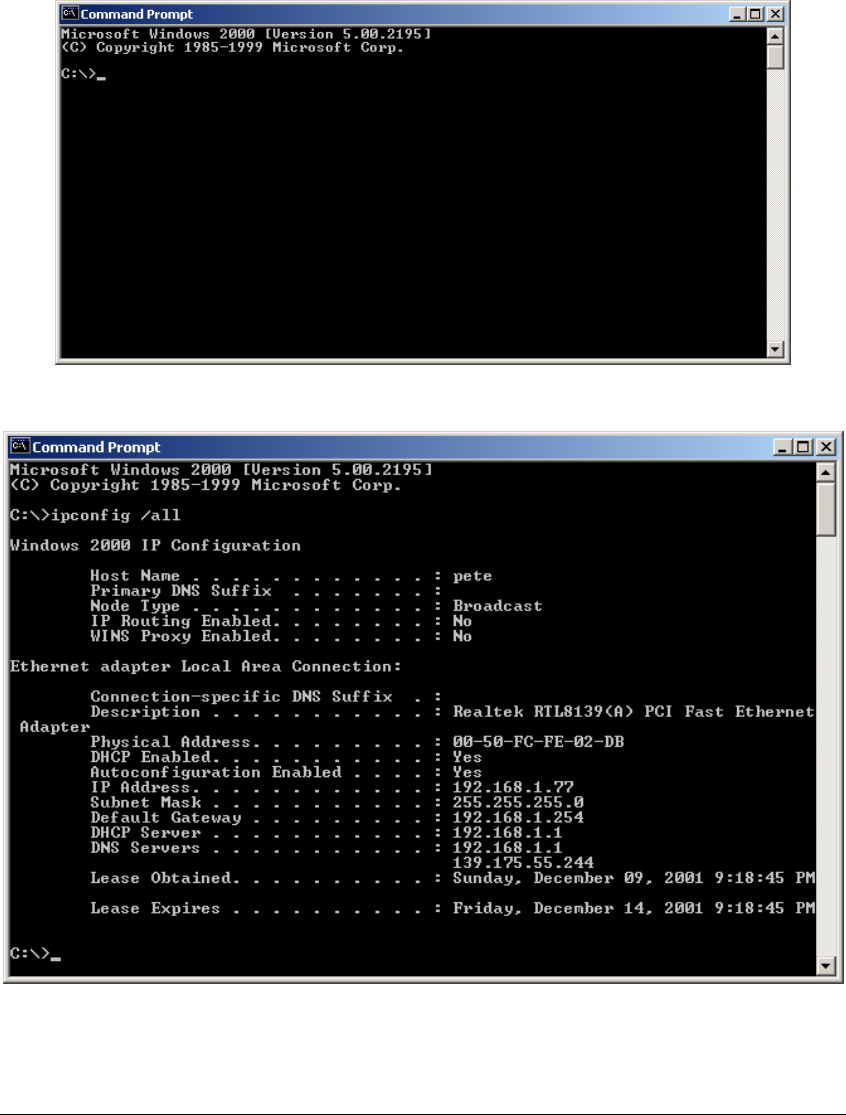
69
Appendix A
How to Manually find your PC’s IP and MAC address
1) In Window’s open the Command Prompt program
2) Type Ipconfig /all and <enter>
• Your PC’s IP address is the one entitled IP address (192.168.1.77)
• The router’s IP address is the one entitled Default Gateway (192.168.1.254)
• Your PC’s MAC Address is the one entitled Physical Address (00-50-FC-FE-02-DB)

70
Glossary
Default Gateway (Router): Every non-router IP device needs to configure a default gateway’s IP
address. When the device sends out an IP packet, if the destination is not on the same network,
the device has to send the packet to its default gateway, which will then send it out towards the
destination.
DHCP: Dynamic Host Configuration Protocol. This protocol automatically gives every computer
on your home network an IP address.
DNS Server IP Address: DNS stands for Domain Name System, which allows Internet servers to
have a domain name (such as www.Broadbandrouter.com) and one or more IP addresses (such
as 192.34.45.8). A DNS server keeps a database of Internet servers and their respective domain
names and IP addresses, so that when a domain name is requested (as in typing
"Broadbandrouter.com" into your Internet browser), the user is sent to the proper IP address. The
DNS server IP address used by the computers on your home network is the location of the DNS
server your ISP has assigned to you.
DSL Modem: DSL stands for Digital Subscriber Line. A DSL modem uses your existing phone
lines to transmit data at high speeds.
Ethernet: A standard for computer networks. Ethernet networks are connected by special cables
and hubs, and move data around at up to 10/100 million bits per second (Mbps).
Idle Timeout: Idle Timeout is designed so that after there is no traffic to the Internet for a pre-
configured amount of time, the connection will automatically be disconnected.
IP Address and Network (Subnet) Mask: IP stands for Internet Protocol. An IP address consists
of a series of four numbers separated by periods, that identifies a single, unique Internet
computer host in an IP network. Example: 192.168.2.1. It consists of 2 portions: the IP network
address, and the host identifier.
The IP address is a 32-bit binary pattern, which can be represented as four cascaded decimal
numbers separated by “.”: aaa.aaa.aaa.aaa, where each “aaa” can be anything from 000 to 255,
or as four cascaded binary numbers separated by “.”: bbbbbbbb.bbbbbbbb.bbbbbbbb.bbbbbbbb,
where each “b” can either be 0 or 1.
A network mask is also a 32-bit binary pattern, and consists of consecutive leading
1’s followed by consecutive trailing 0’s, such as
11111111.11111111.11111111.00000000. Therefore sometimes a network mask can also be
described simply as “x” number of leading 1’s.
When both are represented side by side in their binary forms, all bits in the IP address that
correspond to 1’s in the network mask become part of the IP network address, and the remaining
bits correspond to the host ID.
For example, if the IP address for a device is, in its binary form,
11011001.10110000.10010000.00000111, and if its network mask is,
11111111.11111111.11110000.00000000
It means the device’s network address is
11011001.10110000.10010000.00000000, and its host ID is,
00000000.00000000.00000000.00000111. This is a convenient and efficient method for routers
to route IP packets to their destination.
ISP Gateway Address: (see ISP for definition). The ISP Gateway Address is an IP address for
the Internet router located at the ISP's office.
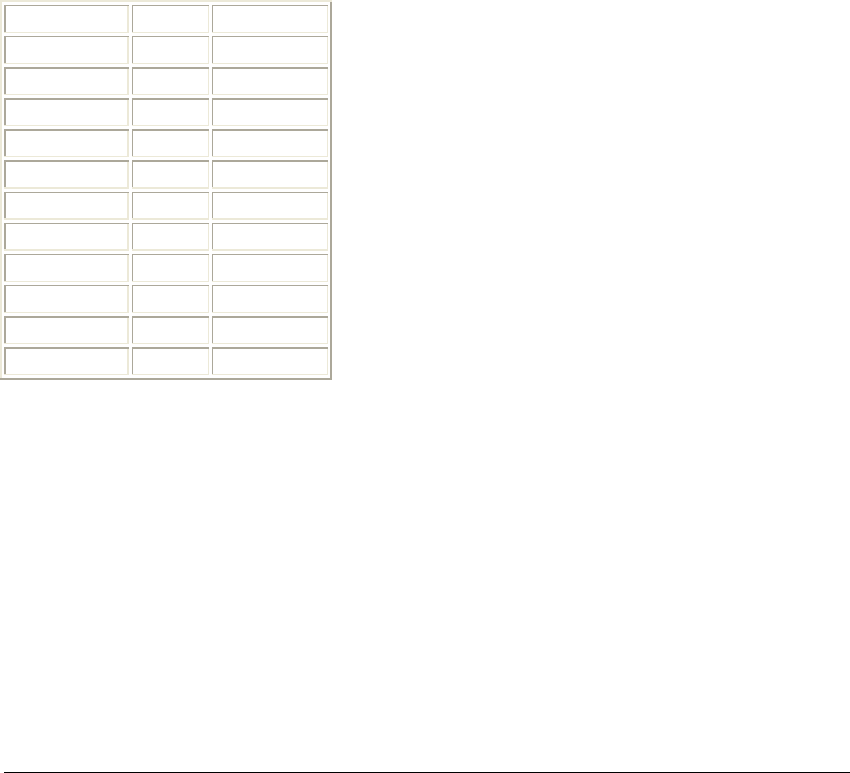
71
ISP: Internet Service Provider. An ISP is a business that provides connectivity to the Internet for
individuals and other businesses or organizations.
LAN: Local Area Network. A LAN is a group of computers and devices connected together in a
relatively small area (such as a house or an office). Your home network is considered a LAN.
MAC Address: MAC stands for Media Access Control. A MAC address is the hardware address
of a device connected to a network. The MAC address is a unique identifier for a device with an
Ethernet interface. It is comprised of two parts: 3 bytes of data that corresponds to the
Manufacturer ID (unique for each manufacturer), plus 3 bytes that are often used as the product’s
serial number.
NAT: Network Address Translation. This process allows all of the computers on your home
network to use one IP address. Using the broadband router’s NAT capability, you can access the
Internet from any computer on your home network without having to purchase more IP addresses
from your ISP.
Port: Network Clients (LAN PC) uses port numbers to distinguish one network
application/protocol over another. Below is a list of common applications and protocol/port
numbers:
Application Protocol Port Number
Telnet TCP 23
FTP TCP 21
SMTP TCP 25
POP3 TCP 110
H.323 TCP 1720
SNMP UCP 161
SNMP Trap UDP 162
HTTP TCP 80
PPTP TCP 1723
PC Anywhere TCP 5631
PC Anywhere UDP 5632
PPPoE: Point-to-Point Protocol over Ethernet. Point-to-Point Protocol is a secure data
transmission method originally created for dial-up connections; PPPoE is for Ethernet
connections. PPPoE relies on two widely accepted standards, Ethernet and the Point-to-Point
Protocol. It is a communications protocol for transmitting information over Ethernet between
different manufacturers
Protocol: A protocol is a set of rules for interaction agreed upon between multiple parties so that
when they interface with each other based on such a protocol, the interpretation of their behavior
is well defined and can be made objectively, without confusion or misunderstanding.
Router: A router is an intelligent network device that forwards packets between different
networks based on network layer address information such as IP addresses.
Subnet Mask: A subnet mask, which may be a part of the TCP/IP information provided by your
ISP, is a set of four numbers (e.g. 255.255.255.0) configured like an IP address. It is used to

72
create IP address numbers used only within a particular network (as opposed to valid IP address
numbers recognized by the Internet, which must be assigned by InterNIC).
TCP/IP, UDP: Transmission Control Protocol/Internet Protocol (TCP/IP) and Unreliable Datagram
Protocol (UDP). TCP/IP is the standard protocol for data transmission over the Internet. Both TCP
and UDP are transport layer protocol. TCP performs proper error detection and error recovery,
and thus is reliable. UDP on the other hand is not reliable. They both run on top of the IP (Internet
Protocol), a network layer protocol.
WAN: Wide Area Network. A network that connects computers located in geographically
separate areas (e.g. different buildings, cities, countries). The Internet is a wide area network.
Web-based management Graphical User Interface (GUI): Many devices support a graphical
user interface that is based on the web browser. This means the user can use the familiar
Netscape or Microsoft Internet Explorer to Control/configure or monitor the device being managed.